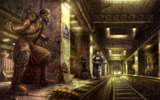INTRO:
There are people who have fond memories of the days when Fallout 2 and Arcanum were considered complex and challenging RPGs for their time. Some of these people decided that there should be such a game for the present era, updated with the best of present-day design practices while retaining some notably classic traits. Stygian Software is some of these people, and their offering is Underrail.
PREMISE:
Underrail is set in a fictitious version of the world with a sci-fi post-apocalyptic future. This is nothing new of course, but it is also set underground.
Humanity has been eking out a life under the surface, which is inaccessible for reasons which will not be explained until much later into the game. Fortunately for humanity, there is a subterranean world underneath the surface, and it can support life, albeit life which does not depend on sunlight. Unfortunately, there are also terrible things that lurk in the darkness, not least of which are humans who have become a tad too accustomed to life underground.
That said, Underrail is set in a portion of this underground realm; this portion is the eponymous “Underrail”, and it is so named because of its network of train tracks. The Underrail was also formerly the domain of BioCorp, a powerful corporation that has since crumbled due to some initially unknown catastrophe that occurred many years before the events of the game’s story. People in the Underrail have since established several stable settlements of varying technological sophistication. Incidentally, many of these settlements are centred around train stations.
One of these settlements is the South Gate Station, which in recent years has become powerful enough to project its influence across a sizable territory that is the caves of Lower Underrail.
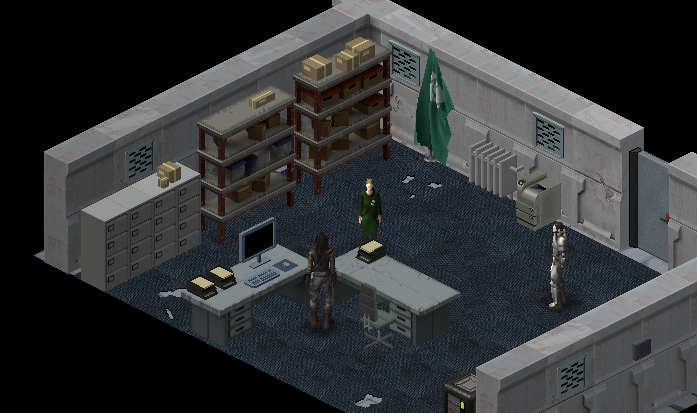
The player character is one of the Station’s most recent recruits. Coincidentally, the player character has joined at a time after an earthquake has just happened. The earthquake has caused collapses that closed off sections of the Underrail. Unsurprisingly, the player character would soon be tasked with reconnaissance of the Station’s immediate surroundings, and the removal of debris which has blocked off the station from the rest of the Underrail network.
Eventually, events take a more distressing turn. The player character, having proven to be reliable and resourceful (as is often the case with the protagonists of post-apocalyptic stories), is tasked with investigating these events. Through these, the player would learn more about the backstory of Underrail and how the Underrail came to be.
It has to be said here though that much of the story-telling is about world-building. Almost every chapter of the game is about the inclinations of this or that faction, the origins of settlements, the nature of the denizens of the underground (human or otherwise) and such lore that has been designed for this game. Of course, there is nothing wrong with this kind of story-telling. In fact, it is done decently, because there is an overarching story that relates all the world-building together. On the other hand, one could argue that each of the plot elements conveniently involves one part of Underrail or another until all of them have been accounted for.
NOT TO BE MISTAKEN FOR A CERTAIN OTHER GAME…:
Underrail went under the radar of most people, likely because it came out in the wake of Undertale. Considering that both games tug at strings of nostalgia, both have underground settings, both have monsters in them, and they have similar-sounding names, it would have been quite easy to have overlooked Underrail if one is not already invested in Stygian Software’s product.
LONESOME PLAYER CHARACTER:
For whatever reason, South Gate Station’s leadership insists on sending out their agents on their lonesome. Therefore, the player character is on his/her own for much of the game.
Indeed, the greatest threat that the player character would face is the numerical superiority of his/her enemies. In fact, he/she is almost always outnumbered. If the player planned poorly, or not at all, the player character would die in just a turn or two from the combined assault of multiple enemies. The game makes this very clear early on through tasks that have the player character facing packs of Rathounds, beasts which draw strength from their numbers.
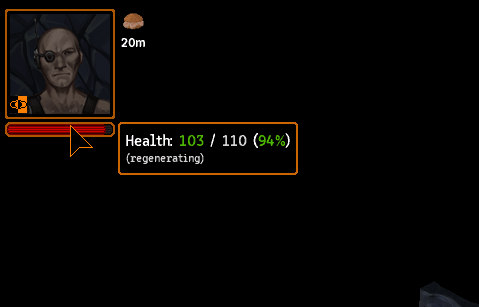
There are times when the player character is not fighting alone. Unfortunately, this does not necessarily make things easier. Most CPU-controlled enemies do focus their strength on individual targets, and if the player character seems to be the physically weakest member on his/her side, the enemies will target him/her first.
Moreover, when fighting together with NPCs, the player has to be mindful of the use of area-effect attacks and burst-fire. Any of these which hit the allied NPCs, regardless of whether it was intentional or not, will turn the NPCs hostile (not unlike what happens in the original Fallout titles). In fact, an observant player might notice that having allied NPCs around is more of a hindrance than a help.
CHARACTER BASE ABILITIES:
Much like Western RPGs of yore, there are a set of statistics which determine the capabilities of the player character. In this game, they are called “base abilities”.
There is Strength, which determines how much stuff the player character can carry and how much damage that he/she can do with melee attacks. Strength also determines the types of equipment that the player character can use. For example, most Assault Rifles require a strength of 6 point in order to be used.
Dexterity determines the player’s skill at using small and easy-to-bear weapons, and at doing tasks that require finesse. For example, having a higher dexterity reduces the action point cost of using handguns.
Agility determines how quick the player character is and how far he/she can move in a certain amount of time. For example, agility determines how many movement points which the player character has when engaging in combat.
Perception is important to any character who is using ranged weaponry. Higher Perception increases the percentage of their to-hit rolls. Perception is also the main method of finding secret places.
Will is the statistic that influences some conversation-oriented skills. More importantly, Will determines the power of a psionics-capable player character. (There will be more elaboration on psionics later.)
Intelligence is used as a factor for many crafting-related skills. However, its effect on combat is next-to-none, unless the player character is a psionic, in which case Intelligence does affect the psionic’s energy regeneration rate, albeit to a lesser extent than Will does.
Constitution determines how tough a player character is. This is perhaps the least important of the base abilities, because it is not a factor for much of anything else.
Generally, it is in the player’s interest to keep the base abilities at 5 points and above. Anything below that imposes penalties on the use of skills and other capabilities that are related to the base abilities.
Of course, there are character builds that do have deficient base abilities and have measures to deal with these deficiencies. However, base abilities are set at the start of the playthrough; therefore, any deficiencies are suffered right from the start of the game, and likely before the player character has gained any means to compensate for these. In other words, characters with deficiencies are only for players who are very much experienced in the pacing of the challenges in Underrail.
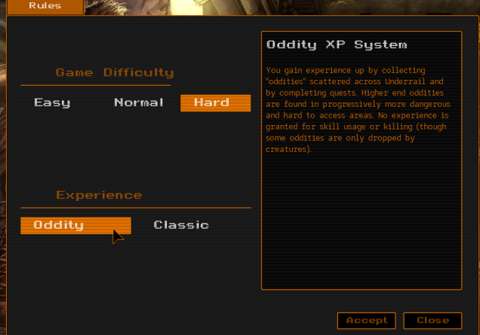
ODDITY XP SYSTEM:
One of the gameplay elements that were praised a lot by people who really like Underrail is its “Oddity XP” system. This system has the player character gaining precious experience points by finding “oddities”, which are artefacts, relics, organs and peculiar knick-knacks which are found throughout the Underrail. Furthermore, there is a limit on the experience points that can be gained from specific types of oddities. In this system, experience points are also gained by completing quests.
At first glance, this would mean that the player character does not have to be blood-thirsty, e.g. killing anything or anyone that can be killed to accrue experience points.
(By the way, a certain other game with a subterranean setting has spoofed this trend of murderous player behaviour that exploited the “traditional” level-up system.)
Instead, the player would be driven to explore the Underrail, looking for oddities. Indeed, exploration is one of the core appeals of the game.
Yet, it is not without flaws. Some oddities can only be obtained from the remains of slain monsters and wrecked robots, and even so, they are not guaranteed to yield them. Therefore, if the player wants to accrue experience points as soon as possible, he/she would have to find these monsters and robots and kill them, and repeat until the player character has hit the learning limit on the oddities. In other words, the player would still have to be blood-thirsty anyway.
CLASSIC XP SYSTEM:
Of course, for the sake of players who just cannot let go of the “traditional” way of gaining levels in RPGs, Underrail has an option for the system of collecting varying amounts of experience points, typically from kills.
Perhaps the most important advantage that the “classic” system has over the oddity system is that the player is also rewarded with experience points for doing non-combat things. For example, successfully persuading an NPC to do or not do something with the Persuasion skill happens to grant experience points. As another example, picking the locks on locked things also grants experience points. The oddity system does not do this.
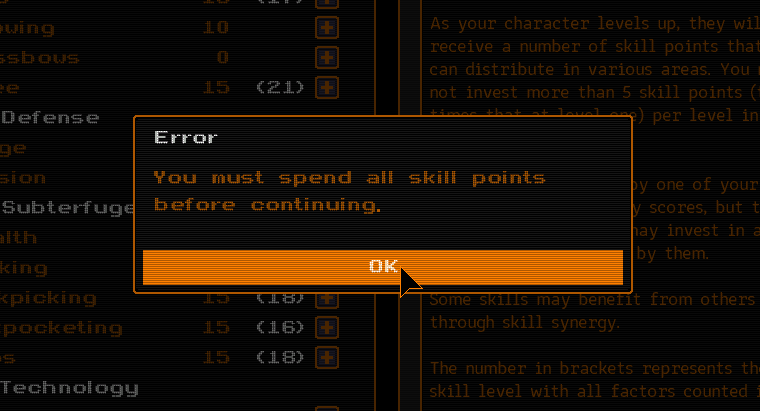
SKILLS:
Like Fallout and Arcanum, there are many skills which the player character can invest in. Most of these skills ultimately contribute to the gameplay of combat, but there are some skills which contribute to role-playing. These skills will be described in their own sections shortly.
OFFENSE SKILLS:
Firstly, there are the usual combat-oriented skills. Obviously, it is in the player’s interest to invest in at least one offense skill, because combat is a gameplay staple in Underrail.
There is Melee, which is for close combat. There is Throwing, which is for throwing dangerous things at enemies. Then, there is Guns, which is of course for shooting things with bullets (and certain other kinds of munitions, which will be described later). Then, there is Crossbow. This is the counterpart for archery in fantastical combat-oriented RPGs.
Obviously, the differences between these skills are the different weapons which are associated with the skills. There are surprisingly considerable differences between different weapon archetypes, as will be elaborated later.
Yet, due to these differences, it is not easy to make use of multiple weapon types without suffering drawbacks like additional encumbrance. It is in the player’s interest to specialize in at least one offense skill, and avoid investing too much in the others unless they provide complementary benefits that are significant enough to outweigh the drawbacks.
“DEFENSE” SKILLS:
There are two defensive skills: Dodge and Evasion. The former is for avoiding attacks in close combat, whereas the latter is for avoiding attacks in ranged combat. Ultimately though, the effectiveness of either skill is dependent on RNG rolls, and much more so than the use of any other skill.
In fact, a player character that does not invest any points into either skill is still viable for gameplay in Underrail. This is because almost all fights can be won with good planning on the part of the player character (barring really bad luck with the RNG rolls, of course).
SOCIAL SKILLS:
“Social” skills are skills which determine interactions with conversant or otherwise sentient NPCs. These work much like the typical conversation-oriented skills in many other RPGs where combat is not always all there is to the gameplay.
To elaborate, there are dialogue options that will not be usable or even viewable unless the player character meets the minima in the number of points in the relevant social skills.
These skills generally have no use in combat. However, the Intimidation skill does determine the effectiveness of a certain debuff-imposing ability that can be unlocked by taking a feat.
Obviously, the Mercantile skill is the main factor in trading with NPCs, which will be described further later.
The other skills are related to gameplay elements which are significant enough to be elaborated in their own sections.
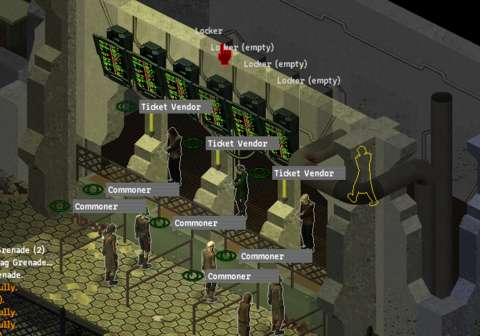
STEALTH - OVERVIEW:
There are several skills that are lumped under the “Subterfuge” category. Among these, perhaps the most important is “Stealth”. The Stealth skill practically determines how effective the player character’s “Stealth mode” is. (Any player character can use Stealth mode, by the way.) A character’s net Stealth skill can be affected by many factors, such as the encumbrance of the armor suit that he/she is wearing.
When the player character enables Stealth mode out of the sight of any NPC, he/she can approach other characters without being detected – at least initially.
There are plenty of factors which determine the effectiveness of the Stealth mode; these will be described in the following sections.
ENTERING STEALTH MODE:
Any characters that can see the player character when he/she enters Stealth mode will continue to be able to detect the player character. However, if the player character can move away out of sight, they will no longer be able to detect him/her after a while.
By the way, other characters do not appear to be alarmed at all when the player character enters Stealth mode within sight of them, even though this should be a sign that the player character is up to no good.
DETECTION RATING & STEALTH RATING:
When a character is in stealth mode, another character uses his/her/its detection rating to determine how effective they are at detecting the stealthy character. The detection rating is determined by a character’s Perception, as well as any gear that increases the detection rating. Their stealth rating also contributes to their effectiveness.
However, in practice, there are three different methods that are used to determine a character’s effective detection rating. One method uses the detection rating itself, while another method uses the stealth rating of the character; the reasonable argument for the latter is that the character’s skill at stealth can be used to find other characters that are in stealth. The third method uses an equation with weights for the detection rating and stealth rating, thus producing a combined rating. The highest rating of the three is used.
This means that most characters would have a chance at detecting a hidden character, unless they have terrible Perception and next to no skill at stealth.
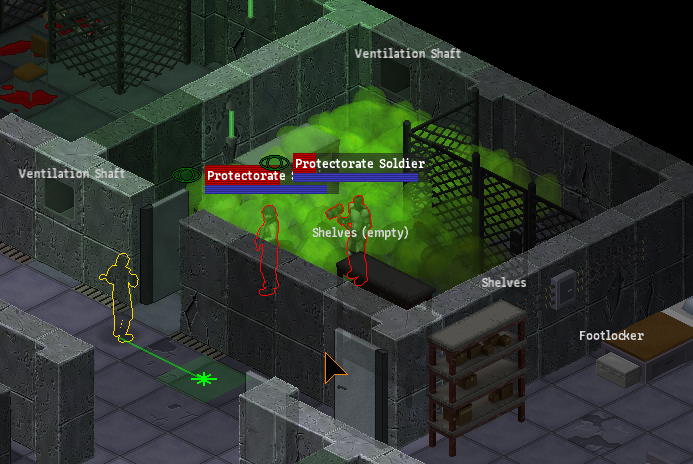
DETECTION PROGRESS:
Other characters may not be able to spot a stealthy player character at first, but they will eventually do so if the latter lingers around for too long. This occurs earlier if the other characters have effective detection ratings that are higher than the stealthy character’s stealth rating.
The progress of their detection of the player character is depicted by coloured eye icons that appear above their sprites. These icons appear after the player character has gotten into what can be considered their “sight range”, i.e. the maximum distance at which they can spot the player character if he/she is not in Stealth mode. This sight range is not perceivable in any other way by the player (unless he/she applies mods of course).
The colours of the icons determine when the player character is at risk of being detected. It should be quickly obvious to the player that the icons should be anything other than red; when it is, the other characters have detected the player character and will act accordingly if they are hostile.
There are other behaviours that other characters would adopt, depending on the detection status. These will be described later.
DARKNESS:
Despite humanity and non-humanity having adapted to life underground, many of them are still dependent on sight to detect enemies. After all, many of them still have eyes, and the underground is not pitch-black everywhere.
Obviously, darkness aids attempts at stealth. Coincidentally, many places in the underworld are dark or poorly lit. This can greatly delay the progress of the detection meter. However, this advantage of darkness is negated by others through their use of night-vision goggles, or acute non-sight senses.
STALKING DISTANCE:
If the player character moves close to another character while in Stealth mode, the latter begins to detect the player character. Being closer leads to a faster progression in the detection.
The distance at which another character begins to detect the player character is dependent on the difference between the player character’s Stealth skill and the detection rating of the other character, or the effective Stealth rating of the other character, whichever is higher. That said, it can be amusing to watch another character being unable to spot a particularly stealthy player character when he/she is just several feet away.
However, at a distance of just one or two squares away from the other characters, especially if they are facing the player character (more on facing shortly), their detection progress rises rapidly. Therefore, the player might want to keep some distance from them.
Unfortunately, this also means that pickpocketing NPCs while in Stealth mode is much more difficult than it sounds. It also makes one of the feats involving pickpocketing, namely the feat which grants a bonus while the player character is undetected, quite difficult to utilize. (Pickpocketing will be described later.)
IMMEDIATE DETECTION:
If the stealth rating of a character is far lower than another character’s effective detection rating, the other character will always be able to detect the character that is in stealth. This might be unpleasant to learn the hard way; the player character could turn around a corner only to encounter an enemy who already has a red eye icon above his/her/its sprite.
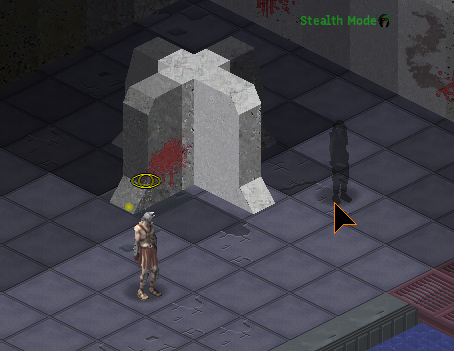
FACING:
As a rule of thumb, it is better to sneak up on the back of another character; the other character’s detection progress is slowest in this scenario. Sneaking past their flanks or their fronts accelerates the detection progress.
Fortunately, the visual designs of the character sprites are adequate at showing the player what can be considered to be the backs of humanoid characters or inhuman things.
ABSOLUTE DETECTION:
There are certain NPCs that have the ability to detect the player character outright. These are often story-critical characters, one of whom is an NPC that is introduced very early. The eye icons above these characters are white in colour.
Interestingly, turrets also have this ability. However, to make them easier to deal with, they have sight ranges that are more limited than other NPCs. (There is also the fact that they stay where they are.)
NOISE:
Noise is also a factor in the gameplay element of stealth. It is up to the player to observe and determine which occurrences create noise and which do not, but the challenge of doing so is quite reasonable.
For example, all gun discharges, unless silenced, make noise, and to various degrees depending on the gun type. The use of heavy machinery also creates noises. Obviously, explosions are very noisy.
All melee weapons are considered silent, including the sledgehammer. There are exceptions though, such as the scenario of a sledgehammer or knife hitting metal plates; the obvious clang or clink of metal hitting metal is a sign that others nearby would likely have heard the commotion.
The use of neural-type psionic powers is considered silent, despite the sound effects that accompany the usage of these powers. However, the other psionic powers produce noise, especially those involving fire and electricity.
Regular crossbow bolts do not make any noise when fired. However, many of the special bolts do make noise. (There will be more elaboration on crossbows later.)
ENEMIES MAKING NOISE:
Human enemies who are struck but not killed outright will usually yell out in pain, or shout a threat at the player character. Strangely though, this does not count as them having made noise. However, if they are still alive by the time their turn to act comes, they will make noise, typically by attacking the player with their weapons. Most enemies, including non-human enemies, will call out to their allies, summoning them over.
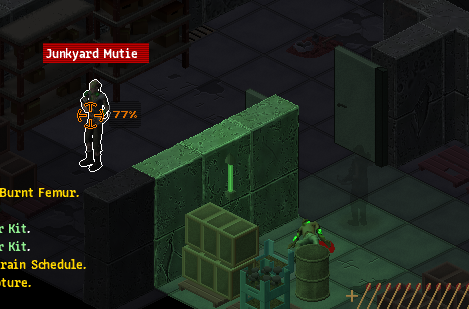
EFFECT OF WALLS AND BENDS ON NOISE:
Noise is also affected by the layout of the level. Yet, like the other aspects of noise, the mechanisms behind this are not apparent to the player, who has to learn through observation, i.e. the hard way.
Walls and doors reduce the range of noise sources. Corridor bends and corners also reduce the range of noise. However, without any indicators of any kind of how much these obstructions reduce the range of noises, the player will have to resort to trial and error.
DETECTION BEHAVIOURS:
When a character’s detection progress is either green or yellow, he/she/it does not make any response. When the progress turns to orange, the character might continue to be oblivious, or he/she/it might become suspicious and move in the direction of the player character. In the latter case, they are likely to eventually bump into the player character, who is generally slower than any other character that is not in stealth mode.
In the case of certain enemies, like Ironhead Bombers (bandits which belong to the Ironhead gang, and they have a predilection for throwing grenades), they might toss explosives instead of approaching the player character. Obviously, these other behaviours are nastier.
BUMPS & GETTING DAMAGED:
Any character that is in stealth mode can be knocked out of stealth by coming into contact with another character that is moving. The key factor here is that the other character has to be moving; a character in stealth mode will not deliberately bump into other characters and will always stop short of the latter.
The other way to knock a character out of stealth mode is to inflict damage on him/her/it, typically through explosives if they have not been detected already. This also includes any damage inflicted on shields, if the character in stealth mode also has shields activated.
ATTACKING OUT OF STEALTH MODE:
Utilizing stealth is a reliable way to get the first attack in combat; in fact, this is the only reliable way to overcome enemies at the highest difficulty setting.
Anyway, a character in stealth mode gains a bonus to his/her/its to-hit chance against a target that has yet to discover the character. There are feats that grant further bonuses, such as the devastating “Snipe” feat.
PICKPOCKETING:
One of the non-combat applications of stealth is pickpocketing. Anything that is not currently equipped by an NPC can be stolen. Conveniently, the player character can start a pick-pocketing attempt at any time and any circumstance on an NPC, just to check the latter’s inventory. The player can then decide whether to go ahead with the theft of anything.
Theft opportunities and risk are governed by the suspicion meter. Like the detection meter, the suspicion meter is determined by actual progress instead of RNGs, which is welcome. Anyway, when the player hovers the mouse cursor over a prospective steal, he/she is shown how much the suspicion meter would fill upon the theft of the item. If the entire meter flashes red, the theft is guaranteed to fail. If it does not, the theft can occur without a problem.
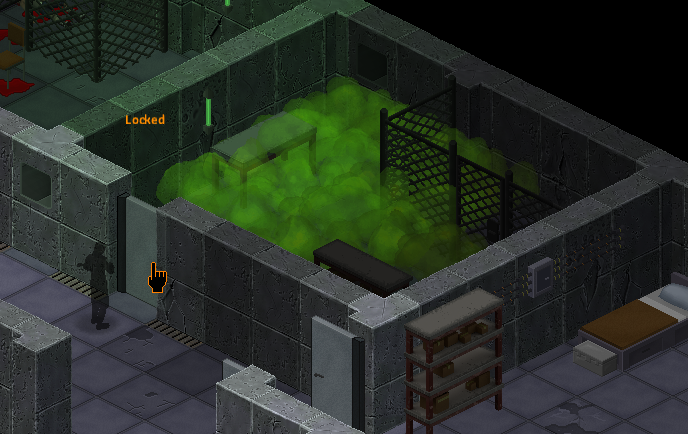
The suspicion meter of a NPC accumulates with subsequent theft attempts. However, the meter does deplete over time, though this can take a while. Nevertheless, this is the only way to relieve NPCs of loot in “controlled zones” (more on this later).
The suspicion meter of each individual character is tracked by the game; this can inflate game-save sizes, if the player has been prolific in emptying the pockets of NPCs.
LOCKPICKING & HACKING:
Stealth-oriented player characters are likely to have invested points into lockpicking and hacking too. There are many doors, mechanical and electronic, that bar progress into an area; opening them not only enables the continuation of said progress, but also tactical opportunities, e.g. using a doorway as a chokepoint, or to break line of sight.
Lockpicking requires the consumption of disposable lockpicks, at least until the player obtains a very special device. Hacking requires a reusable hacking device, but the device has to be powered. Higher-grade lockpicks and hacking devices grant bonuses to the player character’s corresponding skill, but they are more expensive and energy-consuming, respectively.
VENTS:
In addition to doors, there are also vents and the ventilation ducts that they are connected to. To make use of them, the player character has to open them with specific tools, while having the necessary level of Lockpicking to do so. Alternatively, the player character can use crowbars to open them, provided he/she has enough Strength. This is a very noisy process, however, and can be interrupted at any time by suspicious guards.
There are many places with ventilation ducts, which happen to be the most convenient way for a stealth-oriented character to sneak around. Furthermore, only the player character is able to move in and out of ventilation ducts; enemies cannot pursue him/her into them. However, this can only be done while the player character is not engaged in combat. (Enemies also cannot be lured into the ducts.)
That does not mean that ventilation ducts are always safe, however. There are more often than not, rathounds lurking in them. In a certain late-game segment, the ducts can be suddenly filled with cryogenic and poisonous gas too, among other things like explosive drones.
NPC ROUTE PATTERNS:
Not all NPCs stand in place. Some, such as patrolling guards, will move around, usually in pre-determined circuits. If they have been alerted to a disturbance, they have routes calculated for them.
Observation, preferably in stealth mode, helps the player determine when it is best to move past moving NPCs or when to attack them, depending the player’s preferred playstyle.
Some NPCs have staggered routes: they walk along a stretch of their route before stopping for a while to look in specific directions. There is a notable exploit for this: making or reloading a game-save causes any NPC that is at a ‘wait’ position to immediately begin the next stretch of the route. An unscrupulous player can use this to alter the timing of the overlap of multiple NPCs’ routes.
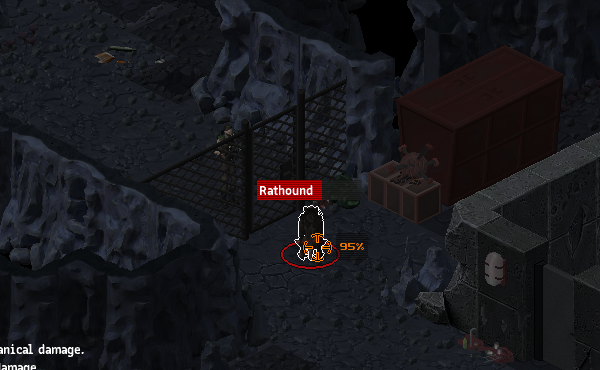
TERRIBLE PATHFINDING FOR NPCS …:
One of the reasons for making use of stealth is that the pathfinding scripts for NPCs are terrible outside of combat. Even a single NPC whose route is unobstructed by other NPCs would run into problems: he/she/it can be caught in level geometries, twitching in place until his/her/its pathfinding scripts are re-executed.
If there are multiple NPCs involved, they are likely to run into each other and further complicate their attempts at following a path. In some of the worst (and most amusing) cases, several NPCs can get stuck in a narrow corridor, completely failing to get past each other. This can make ambushes much easier, if the player can distract them away from their original routes.
… AND THE PLAYER CHARACTER:
Unfortunately, the player character’s own pathfinding scripts are also terrible. If the player designates a destination that is across the map, chances are that the player character would get caught on level geometries, or even has the calculated route terminated when the scripts simply fail upon contact with NPCs.
More often than not, the player has to proverbially hold the player character’s hand all the way from point A to point B. If the pathfinding scripts had been better, the player could have spent his/her time with the game more efficiently, like checking the inventory while waiting for the player character to reach a spot.
ELEVATORS & COMPUTER CONSOLES:
While the player character is in stealth mode, interactions with most electronic things such as electronic locks and switches do not cause him/her to break out of stealth. This does not apply to interactions with elevators and computer consoles.
The reason for this is that interactions with them bring up the dialogue system, which will break the player character out of stealth. This is a terribly unpleasant limitation, because there might be enemies that are lingering around these.
CRAFTING – IN GENERAL:
Many of the items that the player will find are equipment of varying qualities and properties. For example, the player may get a high-quality gun, which means that it inflicts more damage and has higher durability, but it does not have any enhancements that improve its other statistics. In order to have equipment of predictable and controllable quality, the player character will have to craft his/her own.
Crafting is a simple matter of bringing together parts or ingredients; no workbench or fabricating facilities are needed. This can seem unbelievable, but it is convenient.
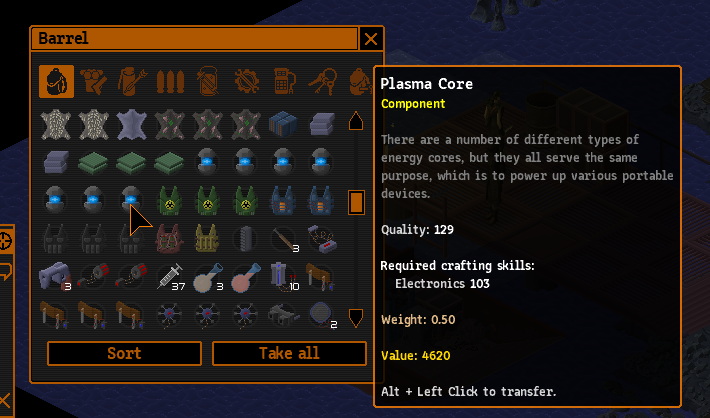
(That said, there are workbenches and facilities, but these are optional for crafting; coming into proximity of them grants bonuses to the player character’s crafting skills.)
In order to craft anything, the player character must already have the schematic for the item; without the schematic, nothing can be done even if the player character has the parts or ingredients. The schematics are contained in portable storage devices (which look a lot like USB sticks) that the player character can then download into his/her wrist device (which is of course a reference to the Pip-Boy).
Selecting the correct recipe is not a simple matter though; the recipes are contained within an alphabetically-ordered list, with no further categorization. At least the player is shown the expected results of a crafting attempt using any permutation of parts; the player can swap parts in and out and watch the numbers change.
There are several skills that are dedicated to crafting; the skills are used for some quests too, but gameplay-wise, they are merely used as variable checks on whether a crafting recipe can be attempted. Some crafting recipes only use one skill, but there are some that use more than one, such as high-tech armor that heals its wearer over time. Indeed, most successful player character builds would include at least one, but more often two or three, crafting skills as their primary skills.
QUALITY:
Some parts and ingredients have quality ratings; these generally determine how potent and/or powerful the item that is to be crafted would be. Obviously, higher quality parts are rarer and more expensive than lower quality ones.
Higher quality parts also require higher crafting skills; this is the most common hurdle that the player would encounter when trying to craft gear. Fortunately, the equations for the required crafting skill levels are easily predictable, assuming that the player can notice the trend of required skill level versus quality.
DISASSEMBLY:
Disassembly is a special variant of crafting; as its name suggests, an item is broken down into its constituent parts. As convenient as this sounds, it does come with a price: any parts with quality ratings will have their ratings reduced after they are fished out of the items. This is likely implemented to reduce the utility of this feature, such as in the case of finding a piece of gear that is of very high quality but has no other enhancements.
For whatever reason, disassembly is not available to the player from the onset and is not obtained through learning a crafting recipe. Instead, the player has to learn it through obtaining the feat that is associated with this feature. This feat then adds a schematic storage device to the inventory. This work-around can seem a tad clumsy.
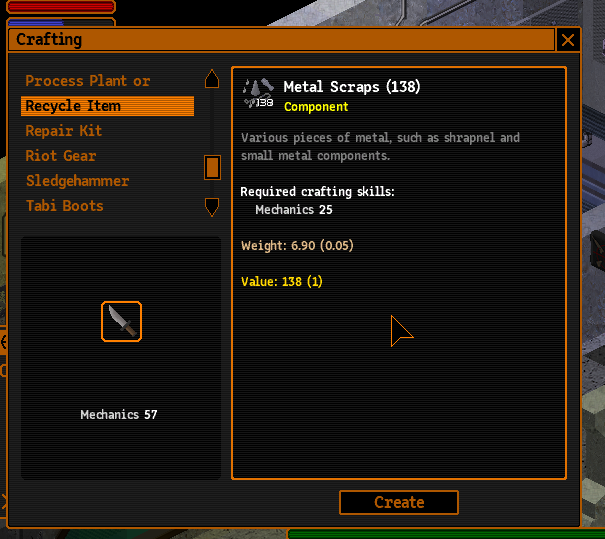
RECYCLING & SCRAPS:
Disassembly is not the only method of breaking down unwanted gear. There is Recycling, which can be obtained through a schematic stick. However, unlike Disassembly, Recycling does not produce item parts; it just turns a piece of gear into scrap. Not everything can be turned to scrap either; only gear pieces with quality ratings can go through this process. Consumables like grenades and ammunition cannot be scrapped.
There are three types of scrap; the type that is yielded upon recycling a piece of gear depends on the apparent majority material of the item. For example, knives are usually turned into scrap metal.
However, sometimes, the results may not be believable. For example, a suit of tactical armor should technically be a composite of fabrics and some metal parts, but recycling it yields scrap fabric. Considering that Disassembly can produce different parts (which are represented with different tabs in the crafting user interface), that Recycling does not have the same sophistication can seem odd. (Recycling fabric-yielding gear does yield rags in addition to fabric scraps though.)
Scraps are primarily used to make repair kits; each type of scrap is used for a specific type of repair kit. There is generally little other use for scraps; few vendors buy them, and only one other crafting recipe uses metal scraps.
Upon having familiarized oneself with the basics of recycling, a meticulous player would learn which gear pieces are better off recycled instead of being sold off as vendor trash. For example, regular knives often yield more value when they are recycled instead of sold, whereas electronic/electrical gear is better off sold.
There is an oddity about recycling: the amount of scraps obtained from an item depends on the durability of the item instead of its weight. Therefore, there can be amusing occurrences, such as gaining 4 weight units of scrap from a knife of 1 weight unit.
DURABILITY & REPAIRING:
Most gear that the player character can equip on his/her person has durability ratings, meaning that that they do not last forever. Higher quality parts result in higher durability, which is understandable.
Fortunately, gear-pieces do not degrade automatically over time; they can only degrade from use. In the case of apparel, they degrade from enemy attacks. The degradation of weapons are particularly notable, mainly because they are the gear that will be used the most.
After the durability of a piece of gear has fallen below 50%, the performance of the gear drops. Weapons are less accurate, armor absorbs less damage and any bonuses conferred by a piece of gear are reduced. (Conferred penalties are not affected.) Warnings also appear, so the player would be notified of the need for repairs.
Speaking of which, there are no vendors that would help the player character repair degraded gear. Instead, the player character has to use repair kits on them; no skill checks are required, conveniently. However, repair kits have to be bought or crafted from scraps, so the player has to consider the economic feasibility of repairing something against just using something else. (Fortunately, repair kits are light things, though the scraps that they are made from are quite heavy.)
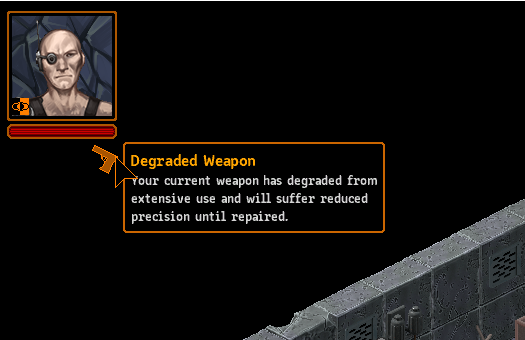
Repairs cannot be done during combat, obviously. Repairs also break the player character out of stealth, though it makes no noise.
QUALITY OF METAL PLATES DOES NOT MATTER IN SOME SCHEMATICS:
The crafting of bullets, throwing knives, bear traps and serrated bolts consumes metal plates. Metal plates have quality ratings, but they are not relevant to the schematics of these items. This can pose a logistical problem, because the player has to seek out low-quality plates for the making of these items while reserving higher quality ones for other schematics.
There could have been a better solution for this, such as the replacement of the plates with metal scraps; after all, bullet heads are small things, throwing knives are smaller than combat knives and serrated bolts are shafts with shaped heads. Another alternative solution is that the quality of the metal plates could be reduced instead of the metal plates being consumed completely.
COMBAT – OVERVIEW:
Ultimately, combat is the main gameplay element of the game; most of the other gameplay elements lead to it anyway. There are pacifistic solutions to some quests, but it is unlikely that the player can avoid combat throughout the entirety of a playthrough.
Combat is a turn-based affair (for the most part; more elaboration on the exceptions later). Every participant has his/her/its own turn in a sequence that includes all participants. Characters who get to act first obviously have an advantage. After the last character in the sequence has made its move, the current round ends and the next round begins.
Each participant has a limited pool of movement and action points that they can spend on doing things. The participants do their best to utilize whatever offensive capabilities that they have while minimizing any damage received. A fight, of course, ends when only one faction of characters remains.
There are some nuances about combat that will be described in their own sections.
NPC-VS-NPC COMBAT:
If the player character is not involved in a battle in any way, e.g. the player character is in stealth mode and has not been detected, the battle occurs in real-time.
Generally though, the player will not see such fights occur outside of cutscenes. That is, unless the player managed to lure characters into characters of factions that are hostile to the former. For player characters that are stealth-oriented, this can be a useful tactic.

ACTION POINTS:
Underrail is one of the hold-out Western RPGs that retain the use of dozens of Action points, instead of the present-day trend of one or two moves.
In the history of games that use this system, this system did not always result in balanced gameplay, especially if the power development of the player character involves the increment of its pool of Action points. This is not the case in Underrail, because characters generally have just 50 Action points to spend per turn, regardless of their character level. They may suffer penalties that reduce these, or have buffs that increase these, but these are not easily available and are ultimately temporary.
MOVEMENT POINTS:
Usually, in games that use the old Action point system, Action points are also used for moving about. This means that the player has to divvy the points between doing things that actively hurt the enemy and getting the player character to a more advantageous location. This works best if the player character can progressively gain more Action points, but Underrail does not do this.
Underrail has an alternative: Movement points are used for movement, and they are by default divested from Action points. To elaborate, characters have a separate pool for Movement points; after exhausting these points, they use Action points for any further movement.
The pool of Movement points is much easier to expand than the pool for Action points. For example, improving Agility increases the number of Movement points. There are also a few feats that temporarily increase Movement points and gear that provides a semi-permanent boost.
Generally, characters that use ranged attacks are not likely to move much, due to considerable penalties for moving and shooting for the use of some types of weapons. Obviously, melee-oriented characters would want as many of these as possible.
Most armor suits apply penalties to the amounts of movement points that a character can have. For example, characters with plate armor are not likely to be able to move around much in combat.
DAMAGE ELEMENTS:
Obviously, to kill anything, damage has to be inflicted on it. There are several different types of damage, which are there to deal with the innate defences of the target.
There is ‘mechanical’ damage, which is inflicted by all bullet-shooting weapons and melee attacks that rely on physical collisions. This is the most common type of damage. Next, there is ‘fire’ damage, which is caused by anything that burns. Typically, this is inflicted through incendiaries. Then, there is ‘cold’ damage. Cold damage is rare, because they can only be inflicted through cryogenic means.
After that, there is ‘electrical’ damage. This is inflicted through anything that applies electrical shocks, such as tasers. There is ‘acid’ damage, which as its name suggests, is inflicted through dousing by acid.
The last type of damage is ‘biological’ damage. This is inflicted by poisons and certain other organic means of harming living things.
Environmental hazards can also inflict these types of damage. In their case, the damage type that they inflict should be obvious. For example, green clouds indicate the presence of toxic gases, which inflict biological damage.
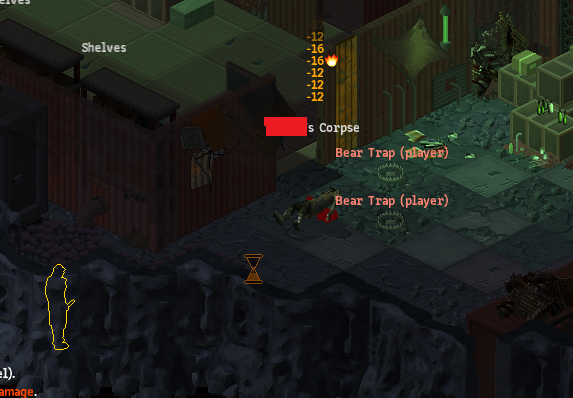
RESISTANCES & THRESHOLDS:
The best defence against any kind of attack is not to be hit, and the best way to deal with hazards is to avoid them instead of going through them. Of course, this is easier said than done. Attacking enemies is not always possible without exposing oneself to attacks in turn, and having to pass through hazards can be sometimes a requirement in exploring certain places. For these occasions, there is the system of resistances and thresholds. Every character has these, to varying degrees of significance.
Resistances block damage by amounts according to their percentage-based ratings; this is the first layer of damage reduction. In the case of human characters, the armor that they wear provide the resistances; if their armor deteriorates to critical levels, the resistances drop. Non-human things usually have their own innate resistances; for example, robots have 100% resistance to biological damage, as befitting their non-organic status.
Thresholds block damage by specific integer-based amounts; they are applied after resistances have reduced damage. Thus, there is the possibility that the resistances can reduce damage to the point that any remainder is eliminated by thresholds. Veterans of the earliest two Fallout titles would recognize this system almost immediately.
If the player wishes to use armor-piercing attacks or ammunition, the player should consider the details of such things; some attacks or ammunition bypass both resistances and thresholds, while others only bypass one or the other. They have various degrees to their bypassing capabilities too.
SHOOTING – FOREWORDS:
Many humans (and human-shaped enemies) make use of firearms and other kinds of guns. This is just as well, because the underworld is not a safe place. Shooting in an underground environment is not exactly an easy matter though. There are many factors to consider, as will be described shortly.
CHANCE-TO-HIT RNG & 95% MAXIMUM FOR RANGED & MELEE WEAPONS:
For better or worse, shooting is a gameplay mechanism that involves luck as a factor. Of course, any character’s probability of hitting a target is determined by many other circumstances, which will be described later. Yet, ultimately, any attack with any ranged or melee weapon is an all or nothing affair: either the hit lands, or it goes wide.
This complaint would have been more acceptable if there are ways to guarantee a 100% chance-to-hit with a ranged or melee weapon, but this is not the case. The chance-to-hit probability can only reach a maximum of 95%. This means that attacks can miss even in very favourable circumstances, such as missing an incapacitated enemy at point-blank range.
This limitation would have been understandable to some degree where ranged weapons are involved; shooting in real-life is not an easy thing to do, even if the target is hapless. Yet, this also extends to melee weapons. One would think that a wide swing with a sledgehammer would hit a stunned enemy that is right in front of a character, but a miss is still possible.
Perhaps the 95% maximum was intended as some kind of balancing measure, yet the circumstances and factors that go into the calculation of the probabilities should already be sophisticated enough to act as such.
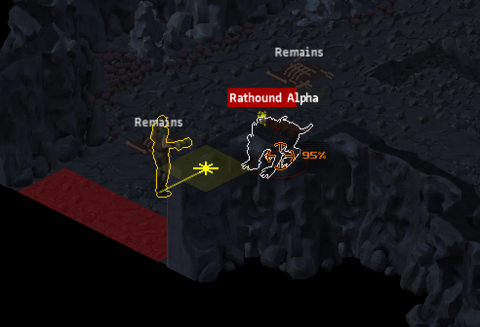
DARKNESS (AGAIN):
Speaking of circumstances that affect shooting, darkness is one of them. It impedes shooting like it does against the detection of characters in stealth mode. Not every creature has developed the ability to see in the dark, including the player character. Therefore, there are methods of illumination that can be used to make shooting easier.
Firstly, there are flares, which can be thrown about; they are also a method of defence against incoming packs of rathounds. Then, there are fires, which are sources of illumination as much as they are sources of painful death. Next, there are lights in the environment; these are not just for aesthetics. For example, blinking lights will turn on in one turn, providing illumination bonuses, and then blink out in the next turn, removing the bonuses. On the other hand, they won’t run out permanently like flares and fires would, but they are not necessarily more reliable.
NIGHT-VISION:
Illumination sources cannot drive away all of the darkness penalties, but night-vision goggles can remove them entirely, at least for the wearer. In fact, night-vision goggles are a must for places that are virtually pitch-black and inimical to both combat and exploration.
However, night-vision puts a green tint on everything and appears to remove shadows for sprites. This necessitates the use of the highlight tool to locate other characters and interactive objects.
Night-vision goggles run on batteries, so they cannot be used indefinitely. Like other gear with energy capacities, they cannot be recharged during combat. Furthermore, night-vision goggles render the wearer vulnerable to flashbangs, which inflict the undesirable “Dazed” effect on the wearer.
GOGGLE LENSES:
Night-vision is an optional upgrade to goggles, though it has to be included when crafting goggles with the (required) lenses and frames.
Lenses decide the type of bonus that a set of goggles would provide, though all but one of the bonuses are primarily meant for ranged combat.
All player characters would do better by having a pair of motion-tracking goggles around than not. There are many enemies that enter stealth mode whenever they can.
FIREARMS:
“Firearms” is a catch-all term for any gun that fires bullets, and firearms happen to be the most common ranged weapons. There are several types of firearms: pistols, submachineguns (SMGs), assault rifles and sniper rifles. (The omission of shotguns is glaring, but apparently, it is being reserved for an expansion to the game.)
Interestingly, the developers have invested considerable effort into differentiating them, perhaps with the exception of differences between SMGs and assault rifles.
Pistols are one-handed guns, which allow the use of riot armor with shields. They are also the firearms that are the easiest to use; player characters that do not have much skill in guns can still obtain a chance-to-hit of more than 50% at point-blank range. There is no dual-wielding of pistols, but pistols are the only firearms that can be used together with riot shields.
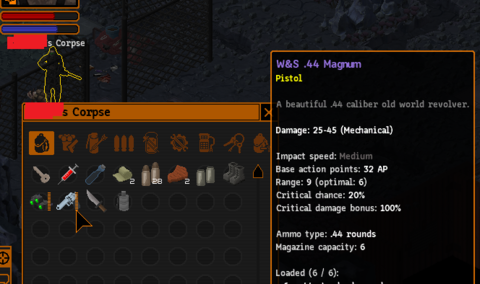
SMGs are two-handed guns and are just a bit heavier than pistols. SMGs have the least action point cost to use, but have the least damage per shot for the same calibre of bullets. SMGs can be fired in bursts to improve their damage output, at the cost of some accuracy.
Assault rifles are practically heavier SMGs, with higher action point costs and higher damage per shot. They generally require Strength ratings of 6 and higher to be used effectively.
Sniper rifles have the highest damage per hit in the game. However, they also have the highest action point costs, often 40 or more. They are also one of the loudest things in the game, second only to explosive grenades. Moreover, they have minimum effective ranges, i.e. how close the target can be without causing the player to suffer a penalty to chance-to-hit for having an enemy within close proximity.
FIREARM FEATS:
The differences between firearms that have been mentioned may not seem like a lot. However, there are feats that affect the use of specific firearm types. For example, there are feats that increase the number of bullets that SMGs and assault rifles fire in burst-fire. A few of these feats overlap with the use of other types of ranged weapons, so the feats can be used in more than a few character builds.
BURST-FIRE:
SMGs and assault rifles can fire in full-auto bursts. Obviously, they spend more bullets this way than they do with single shots. The chance-to-hit for each bullet is lower too. Their maximum chance-to-hit percentage is 80%, meaning that they are more exposed to the fickleness of the RNGs than most other ranged weapons.
However, this does not mean that any bullet that missed is completely wasted; any shot that missed the primary target has a chance to hit something else that is close to the primary target. This means that the damage output from burst-fire has another layer of certainty than single shots do.
ENERGY & CHEMICAL PISTOLS:
Most guns shoot bullets, but there are handguns that fire something else. These are the energy and chemical pistols. At first glance, they appear to be in the game to remind the player of the game’s sci-fi settings, e.g. there are guns that fire energy projectiles or incendiary substances like flamethrowers would.
In practice, they provide characters that have considerable investment in certain crafting skills with the means to inflict non-mechanical damage through the use of the appropriate pistols. For example, the Electronics skill provide the means to craft electroshock pistols that can inflict electrical damage. (By the way, electroshock pistols can harm multiple targets, if they are close to each other.)
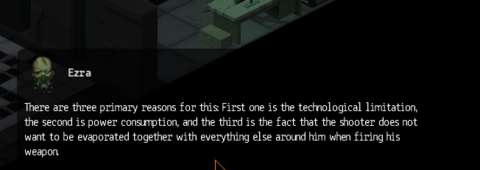
Energy and chemical pistols count as pistols; any feat that affects the usage of bullet-shooting pistols apply to them too. This can lead to some interesting character builds, though not necessarily overpowered ones; these sci-fi pistols take more Action Points to use than most bullet-shooting pistols.
There are three types of energy pistols: laser, plasma and electroshock. Laser is mainly for anti-armor purposes; it inflicts energy damage, which is resisted by very few things short of energy shields (more on this later). Plasma does a mix of laser and fire damage, and is meant for softer targets. Electroshock pistols can damage more than one enemy, but it has the shortest range and there are armor parts that specialize in improving resistance to electrical damage.
Chemical pistols are practically de-buff applications. All of their shots come with the chance of applying a de-buff on the target; the probability of this chance can be improved by using chemical dispensers of higher quality.
NO OTHER TYPES OF DISPENSERS:
The in-game description of the blueprint schematic for chemical pistols suggest that there are more types of dispensers other than the blob dispenser, which is the only one in the game at this time of writing. Presumably, there may be other types of dispensers, such as one that fires streams. The designs for these other dispensers could have been set aside for inclusion as content in expansions.
CHEMICAL PISTOL PARTS COUNTING AS MEDICAL COMPONENTS:
Perhaps due to a coding oversight, chemical pistol parts count as medical components and thus can be sold to medical service providers, presumably for use in their facilities. On the other hand, this suggests that there may have been ideas on the developer’s part for other kinds of medical equipment.
RELOADING GUNS:
The aforementioned ranged weapons all require reloading, due to their usage of magazines, energy cores or fluid chambers. Reloading is not a simple matter of pressing a button, at least before the player learns how to assign hotkeys for ammunition.
There is a quick command to reload the player character’s currently-equipped weapon, but any other weapon in the player character’s inventory has to be manually loaded by “using” ammunition on them with the user interface. This can be a bit unwieldy.
RELOADING FIREARMS:
There are two scenarios for using the quick command to reload firearms. The first scenario is that the gun is not already loaded with a magazine; in this case, a magazine of regular bullets is loaded, if there is any. The second scenario is that the gun is already loaded with a type of ammo; more of the same type of ammo is loaded in this case.
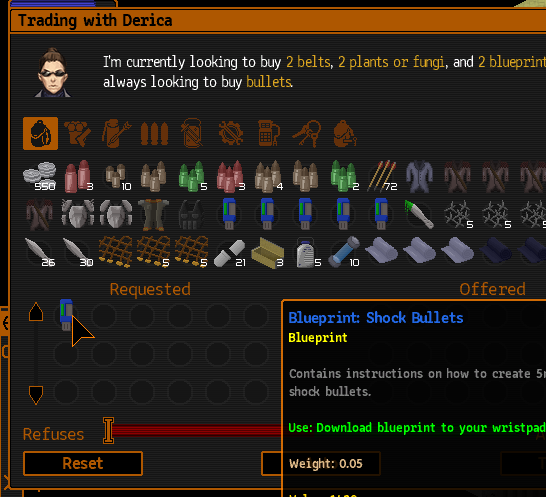
SPECIAL BULLETS:
Firearms have the disadvantage of having to use bullets, which can be heavy. However, bullets have the advantage of being versatile containers for different kinds of payloads. There are several kinds of payloads, some of which can only be obtained through crafting.
There is the regular payload. The player should have a significant amount of this, because there are many enemies that are better off shot with this, especially if the player’s gun is powerful.
Hard enemies, such as certain bugs with tough carapaces and armoured humans, have high mechanical damage resistances and thresholds. Ideally, the player should consider other types of weaponry, such as energy pistols, for more efficient combat.
However, these weapons do not have the range of sniper rifles and they do not do burst-fire, thus limiting their potential to inflict damage. Therefore, using firearms with Armor Piercing (AP) bullets is the most tactically prudent thing to do if the player character specializes in the use of firearms.
Jacketed Hollow Point (JHP) bullets are best used against soft targets; they inflict more damage, but incur greater mechanical resistances. There are several types of enemies that are practically meat tanks, such as Warthogs; JHP rounds are useful against them.
CALIBRE-SPECIFIC SPECIAL BULLETS:
There are other types of special bullets, but each of these is exclusive to a specific calibre of bullets. For example, Shock Bullets, which inflict electrical damage, have to be crafted using 5mm casings.
This can limit the versatility of firearms. For example, there is the 12.7mm Contaminated Bullet, which inflicts a de-buff that causes the target to suffer more damage from further attacks. However, since 12.7mm bullets are only used in Sniper Rifles, the player has to use Sniper Rifles to inflict this de-buff.
Perhaps this limitation is a deliberate decision on the part of the developers, e.g. its purpose is to differentiate the guns further and/or to balance them against each other. Yet, this limitation would have been more acceptable if it has an in-universe explanation.
BULLET CASINGS:
Regardless of the type of payload, all bullets require empty casings. Few merchants sell empty casings, so the main source of casings is from simply shooting guns. Every time a gun fires a bullet, there is a chance that the casing of the bullet is retained; if it does, it appears in the shooter’s inventory. This also applies to enemies too.
However, guns can only be fired if there is a target to shoot at. Fighting enemies is a very inefficient and risky way to get bullet casings. Thankfully, South Gate Station has a firing range that can be used to fire guns willy-nilly in order to get their casings.
On the other hand, it is odd that there is not a crafting option to simply discard the contents of bullets to get their casings. This would have been far more convenient and believable.
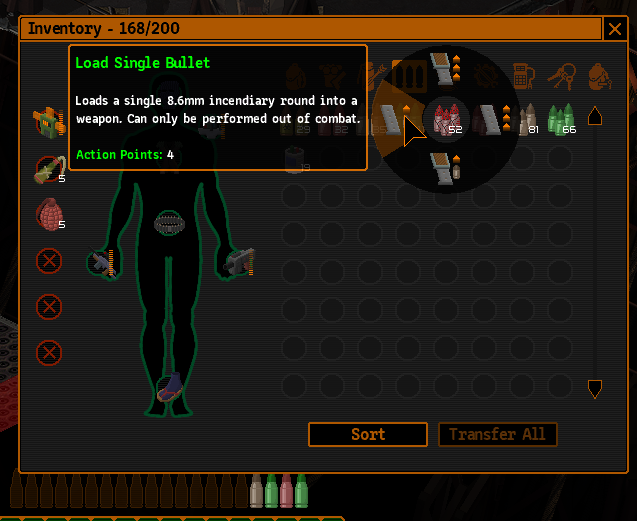
LOADING DIFFERENT BULLETS:
Using the “load single bullet” function, the player can have bullets of different types loaded into the magazine of a gun. This might seem handy for burst-fire, e.g. the player can mix special bullets together with other bullets to apply de-buffs on enemies. However, special bullets of one type can only be of a specific calibre, so the most varied mix that the player could do is to mix special bullets together with regular, AP or JHP bullets. (The basic three types do not belong together in the same magazine.)
Obviously, loading single bullets into the magazine of a gun can take a while.
The most effective use of this function is to load a 12.7mm Contaminated Bullet into a sniper rifle, followed by other rounds so that the first shot applies the Contaminated de-buff. The small size of the magazine of a sniper rifle also makes this loadout easier to follow.
RELOADING CHEMICAL & ENERGY PISTOLS:
Chemical pistols have specific types of chemical collectors, which in turn determine what type of chemical substances that they can use as ammunition. However, the vials of substances are not like magazines of bullets; the fluids are loaded into the collecting chambers of the pistols, and this is a one-way process.
Similarly, energy that has been used to charge energy pistols cannot be recovered in any way. However, energy pistols are easier to reload than chemical pistols, because any grade of battery can recharge them. Batteries are also lighter than vials of substances. However, energy pistols are vulnerable to EMP bursts, which cause any energy that they have accumulated to be drained.
RELOADING IN COMBAT:
Reloading in combat takes precious action points: 25 points, by default. There is a belt that drastically reduces reloading time for bullet-using guns, but there is nothing for energy and chemical pistols. Maintaining damage output in combat is crucial, so it is in the player’s interest to have a full magazine, chamber or core before the next fight, as well as tactically useful items like flashbangs that give the player time to reload.
CROSSBOWS:
Crossbows are an entirely different class of ranged weapons. They have no magazines, chambers or cores; every regular bolt is drawn from the player character’s inventory. Therefore, as long as the player character still has regular bolts, the player character can keep firing. However, in return, crossbows cost a lot of Action Points to fire.
On the other hand, crossbows have high damage-per-hit, at least when compared to other ranged weapons with the same quality ratings. Moreover, crossbows are considered to be silent weapons, at least when firing regular bolts.
Crossbows have the same disadvantages as sniper rifles; they have optimal ranges and lose accuracy if the player character has moved before firing. In fact, crossbows share some feats with sniper rifles, such as the Snipe feat.
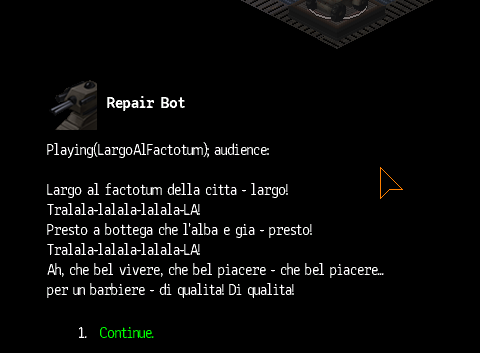
SPECIAL BOLTS:
Crossbows can also fire special bolts instead of regular bolts. However, the usage of the special bolts is different from the usage of regular bolts – perhaps awkwardly so. The regular bolts are automatically drawn from the player character’s inventory, but the special bolts have to be equipped in the player character’s quick-item slots. There is no explanation for this limitation, other than speculation that this represents the need to prep the special bolts for firing.
Consequently too, special bolts are lumped under the category of items that go into quick-item slots; these items can only be stacked in limited numbers - 99 in the case of special bolts. Regular bolts can be stacked to a much higher number.
Awkward gameplay designs aside, special bolts provide greater versatility to crossbows. They also do not need to be manually loaded like special bullets do. Furthermore, compared to their bullet counterparts, special bolts have better guarantees for their effects. For example, Shock Bolts always shock the target if they inflict damage; in comparison, Shock Bullets still have to pass an RNG roll to shock the target.
Some special bolts have effects that their bullet counterparts lack. For example, although the incendiary bolt needs to pass an RNG roll to set the target on fire like incendiary bullets do, the bolt burns anything in its path and is guaranteed to inflict fire damage on them, unlike incendiary bullets.
WIDE ADDITIONAL DAMAGE RANGE FOR SPECIAL BOLTS:
Most special bolts inflict additional types of damage, as stated in their descriptions. However, the additional damage has considerable ranges, so their effectiveness depends on luck as much as the player’s tactical acumen.
MECHANICAL RESISTANCE AGAINST CROSSBOWS:
All crossbow attacks incur greater mechanical resistance from targets. This means that crossbows are especially difficult to use against well-armored targets. There are acid bolts (and corrosive bolts, which can only be obtained much later), but these are not as efficient as AP bullets against such targets.
Perhaps there could have been special bolts that bypass armor, or special bolts that inflict energy damage, but there are not any. Yet, there is the impression that this disadvantage of crossbows has been deliberately emphasized by the developers.
Nevertheless, a player character that specializes in crossbows would eventually have ways of inflicting considerable damage with a single shot. If a well-armored target cannot have its mechanical resistance bypassed, it can still be killed with a shot of overwhelmingly high damage output.
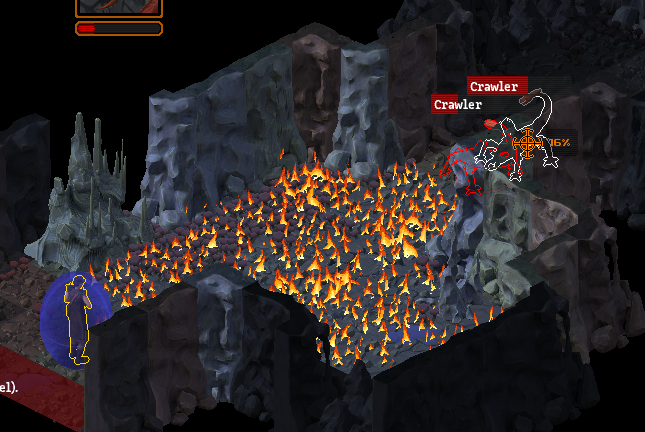
THROWING:
Throwing knives are a class of weapon on their own. Their damage and accuracy rating are completely dependent on the Throwing skill of their user. This can seem problematic at first, but hitting things with knives become incredibly easy after the player character has boosted his/her Throwing skill to close to three digits.
Few feats affect throwing knives, but they are incredibly powerful. One of them roots the target to the spot; this can be followed up with tangling nets and grenades, both of which are thrown weapons. Also, considering that grenades are essential to most player character builds, the player character that focuses on the Throwing skill does not have to divert some skill points to other combat-oriented skills.
The only setback to throwing-oriented builds is that other than certain grenades, there are no anti-armor throwing weapons.
GRENADES:
Grenades are the main way to inflict damage on multiple targets. There are few other area-effect attacks in Underrail, so any character that eschews the use of grenades might have difficulties dealing with multiple enemies (perhaps with the exception of full psionics).
However, since grenades utilize the Throwing skill for the accuracy of throws, skill points have to be spent on the skill if the player wants a character that can reliably harm multiple enemies with grenades.
Grenades have a maximum chance of 90% at landing where the player wants them to land, so luck is a considerable factor in their use. Cheekily, the grenade is the only non-psionic weapon that has a condition for a 100% chance; this condition requires that the grenade be dropped right next to the player character.
(On the other hand, this might be useful if hostile beasts and monsters are mobbing the player character, and he/she has a powerful energy shield.)
NO HEAVY ORDNANCE:
Despite the sci-fi settings of the game, the player should not expect to be able to use the kind of ordnance that is seen in games such as Fallout. There are no miniguns, heavy machineguns, rocket launchers, energy rifles and certainly no tactical nuke launchers.
This is perhaps a good thing, especially in the eyes of RPG veterans that believe that the presence of such big guns detract from the experience of a game. After all, the end-game experiences of the original Fallout titles often involve player characters with powered armor and heavy weapons that make a mockery of their post-apocalyptic setting (specifically the scarcity of high-end technology that makes such heavy hardware possible).
MELEE & DODGING – IN GENERAL:
Many places in the subterranean world have corners and obstacles that limit the effectiveness of ranged weapons. Therefore, melee combat is a viable option in fights, assuming that the combatants are smart enough to make use of cover to minimize incoming fire.
Melee attacks utilize Perception too, but not as much as they do Strength and Dexterity. Besides, range is not an issue; the attacks are point-blank after all. Besides, due to the separation between the Dodge and Evasion skills, a target that is good at avoiding ranged attacks might not be good at avoiding melee attacks (though the converse may also be true).
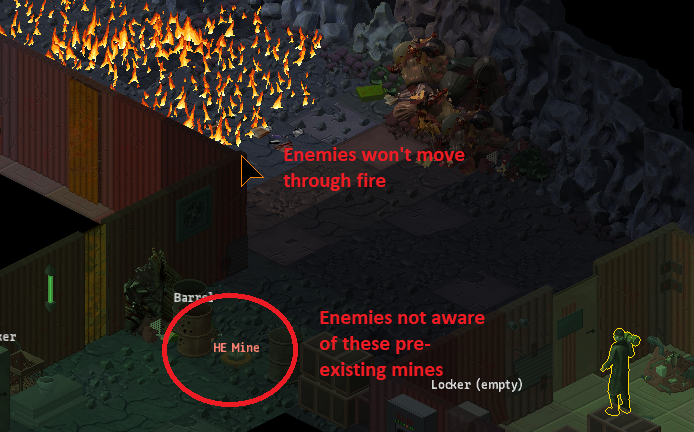
MELEE-WEAPONS:
There are not a lot of melee weapons, however. There are combat knives, sledgehammers and combat gloves, but these are all there is in the base game package. They have some differences in their ability (or inability) to handle mechanical resistances of the target and the cost in action points to use them, but there are few other fundamental differences.
The melee weapons can be upgraded to have secondary effects, of course. However, once the player’s glee at learning this has dissipated, he/she would realize that there are not a lot of options for each type of melee weapon. This is so even though a type of upgrade for a melee weapon might seem feasible for another type of melee weapon.
For example, Combat Gloves have the most upgrade options. Spikes can be added to them and they can be augmented with electricity or pneumatics for additional damage and/or effects.
Understandably, spikes cannot be added to knives, and pneumatics would be difficult to mount on them too. However, sledgehammers should be large enough to accommodate additional spikes and even pneumatic systems, but they can only be upgraded with electricity augments.
(Incidentally, the expansion to the game will implement more kinds of melee weapons.)
CANNOT TURN OFF ELECTRICITY AUGMENTS:
Any melee weapon with a powered augment cannot have its augment turned off. This is not an issue for pneumatised gloves, of course.
However, this can be a problem for electrified knives and sledgehammers. This is because one of the main traits of the electrical augments is that the target emits electrical arcs when it is hit; these arcs will hit other nearby characters (excepting the player character). The electrified attacks can stun the target, but only if an RNG roll is passed.
Of course, electrical augments are desirable if the player character is surrounded by enemies (though this is a scenario that the player should not be getting into in the first place).
However, if there are allied or neutral NPCs nearby, the arcs will hit them, and they will turn hostile. Moreover, the energy spent on the attack is wasted if there is only a single target. Furthermore, the electrical emissions from the attack do make noise.
All these setbacks make electrical augments rather undesirable, and very disappointing if the player was excited about these in the first place.
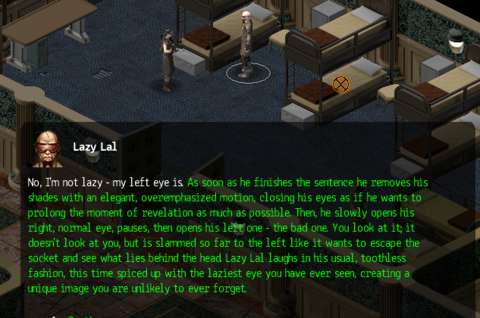
MELEE WEAPONS WITH ENERGY CAPACITY REQUIRING ELECTRONIC REPAIR KITS:
Unfortunately, there are even more problems with augmented melee weapons. Their regular variants generally need mechanical kits to be repaired, or tailoring kits in the case of fabric-made combat gloves. The augmented variants require electronic kits, which are more expensive and less easy to craft than the other kits.
MELEE FEATS:
The feats that improve melee attacks are the only reasons to use melee weapons at all. Some of them grant the ability to apply debilitating de-buffs on the target with mere regular attacks, whereas other allow a character to pull off special attacks that inflict particularly nasty de-buffs.
ENERGY SHIELDS:
Armor can only do so much to reduce damage from hits. Moreover, they do not prevent their wearer from being hit in the first place. Energy shields do protect their wearer completely from attacks, if the conditions are right. Besides, energy shields occupy their own slots, so the player character might as well equip them.
Once equipped, an energy shield can be activated to project an energy field that intercepts incoming fire. However, the amount of damage that it blocks is determined by its ratings, which in turn are determined by the components that went into it.
Speaking of components, there are three main components: the base (which is just there to receive the other two components; it has no quality rating), the energy core (which is also used for many other electronic devices) and the frequency modulator. There are three types of frequency modulators: low, medium and high. These modulators in turn affect the shield’s resistance against projectiles of various impact speeds; impact speeds will be described later.
Generally, it is in the player’s interest to have an energy shield with an energy capacity that is as high as possible, regardless of its other ratings. As an energy shield blocks and absorbs damage, its energy reserves diminish. Furthermore, its energy reserves also deplete automatically over time (or turn to turn, in the case of turn-based combat); the depletion rate is at a percentage of the shield’s total energy reserves too, so the player will not want to spend too much time fighting a battle.
Most importantly, energy shields cannot be recharged during battle. This can seem odd, considering that energy pistols can be recharged. Perhaps this is meant for gameplay balance purposes; after all, energy shields are especially effective when used against specific enemies.
(There is supposedly a means of recharging shields while in combat, but this has not been implemented in the current build of the game at this time of writing.)
For whatever reason, energy shields do not diminish a character’s stealth ability, despite the projection of an obviously coloured field. On the other hand, there is little reason to activate shields when in stealth mode; any damage taken, even by the shield, will knock the character out of stealth mode anyway.
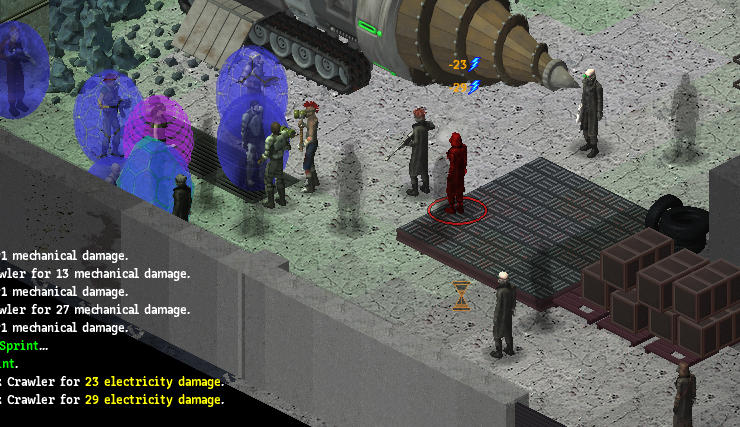
IMPACT SPEED:
In addition to the damage ratings and secondary effects of attacks, there are also their impact speeds. This type of statistic only comes into play when resolving the effects of hits on targets with activated shields.
There are several grades of impact speeds: Very Low, Low, Medium, High and Very High. Very Low is the general grade for melee attacks. Low is for crossbow bolts and throwing knives, and cryokinetic bolts (more on these later). Medium is for most pistols and some submachineguns. High is for most explosive grenades and bullets from rifles. Very high is for laser, plasma and electrical attacks, including those from augmented melee weapons, special bullets, special bolts and psionic attacks.
Shield emitters have ratings that correspond to all of these impact speeds. These ratings indicate the amount of damage that their shields can negate from attacks with specific impact speeds. These numbers are immediately deducted from the raw damage inflicted by a hit, before deductions from armor and other means of protection.
Generally, all energy shields are better at dealing with attacks of High and Very High speed; considering that some of the nastiest, armor-penetrating attacks fall into this impact speed category, this is just as well. The shields work fairly decently against Medium attacks too.
However, the ratings for Low and Very Low speeds tend to be low. This is a deliberate design decision though; melee weapons, crossbows and throwing knives become the optimal weapons to deal with shielded targets.
The player determines the impact speed ratings when crafting shield emitters by using two frequency modulators. One of them is the primary modulator, the ratings of which determine the default ratings of the emitter. The secondary modulator alters the ratings according to proportions of its own ratings.
For example, having a high frequency modulator as the primary means that the emitter is mainly for protection from attacks with energy pistols and rifles. However, having a medium frequency modulator bolsters the Medium impact speed ratings, thus improving the emitter’s protection from SMGs and pistols.
EMP BURSTS:
EMP grenades are the bane of robots and any equipment with an energy capacity. If the EMP waves of the grenades hit robots, they are immediately short-circuited (which is the robot equivalent of being stunned); there are no saving rolls that they can make. However, after the short-circuit lapses, they gain a temporary buff that makes them immune to further short-circuiting.
Any device with an energy capacity that is hit by an EMP wave immediately has its energy reserves drained to zero. Its user is also struck with electrical damage equal to the amount of energy that has been drained. The player should keep this in mind, if only because the player character is likely to be equipping the most items with energy capacities.
TRAPS - OVERVIEW:
Instead of toting weaponry or throwing things, a player character can be tricked out to use traps instead. Traps are not as straightforward to use, of course, but with meticulous planning, entire swathes of enemies (or just unwitting victims) can be slain in a single explosive moment.
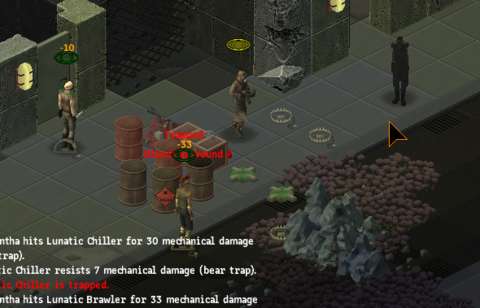
There are two overarching types of traps: those that harm only the one who triggered them, and those that detonate to potentially harm several that are caught in the area of effect. It is easier to plan for the use of the former than the latter. The latter traps require the player to figure out how to lure groups of enemies over, and somehow bunch them up for a collective demise of maximized efficiency.
Traps can be spotted by any NPC, but only human ones would actually avoid stepping on them. Interestingly, if a human NPC has spotted traps, he/she does not share this information with other NPCs, even if they are from the same group. This can be used to the player character’s advantage.
Of course, traps can also be used against the player character. There are many maps with pre-existing traps, which the player character has to spot and walk around. Sometimes, there is no choice but to trigger them, because they are in paths that the player character must step on and the player character is not able to disarm them in any way.
Traps are heavy things, as are their components. A trap-oriented player character will often be weighed down by a considerable number of traps. Yet, traps are just no good as the primary means of inflicting damage during combat, because traps, by default, cannot be set during combat.
(There is a feat that allows the player to set down a trap during combat, but it has a cooldown time and the player has to be canny enough to lure enemies onto the trap.)
Therefore, such a player would have to carry around more readily usable weapons. In practice, this will have to be light weapons.
BEAR TRAPS:
There are no bears in the underworld, but these traps are still called as such and still work as intended: they immobilize their victims and inflict considerable harm. The victims also automatically get a bleeding de-buff.
Their main value is their ability to root victims in place – preferably in front of explosive mines and next to other bear traps that are intended for other victims. After the bear traps have stuck several fools in place, all it takes to eliminate the lot of them is for the explosive mines to be detonated.
It takes experience, considerable trial and error and lots of bear traps to make this happen. Yet, the contrast of such a meticulous strategy against more straightforward ones can be an appeal in itself. Moreover, as long as this strategy is enacted in uncontrolled zones (more on these shortly), the player could systematically murder NPCs in these places without triggering faction hostilities (more on these later too).
ACID BLOB TRAPS:
Acid blob traps are one of the traps that harm only a single target. What makes it different from other traps is that they have delayed triggers. This may seem like a setback, but its effects are always centred on the victim, regardless of how far the victim has moved since triggering the trap.
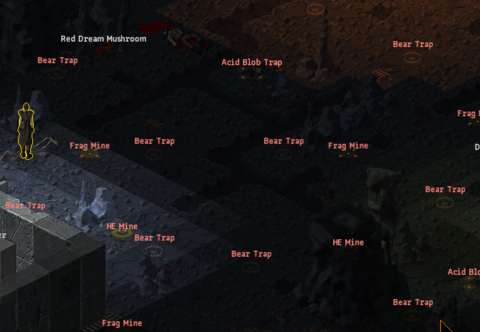
FRAG AND H.E. MINES:
Frag and HE mines will be the mainstay of a trap-oriented player character. However, they have a peculiarity: they can be triggered by other explosives, i.e. each other, and frag and HE grenades. This means that a lot of mines can be wasted if they were triggered with the wrong timing, i.e. only one enemy was on the minefield instead of several. On the other hand, they are the only traps that can be triggered simultaneously (typically by having them blow up next to each other).
T.N.T. CHARGES:
After the player character has cleared the first main hurdle of the game, the game introduces T.N.T. charges. These are practically traps that any player character can use, but T.N.T. charges do not benefit from any feats or bonuses that improve traps. Unlike other traps too, T.N.T. charges are always visible to NPCs. Furthermore, T.N.T. charges work on timers.
On the other hand, NPCs do not register T.N.T. charges as threats in the build of the game at this time of writing; they even walk over them. This means that T.N.T. charges are the main way to eliminate NPCs in uncontrolled zones, at least for characters that cannot lay down traps.
CONTROLLED ZONES:
Traps can be used to kill a lot of unimportant NPCs without triggering hostilities, if only for the sake of gaining regular experience points and looting their corpses. Therefore, there is a system in place to mitigate such abuse: every map in the game has a variable that determines how much freedom the player character has in goofing around with traps in murderous ways.
There are three types of zones: “controlled”, “partially controlled” and “uncontrolled”. In a “controlled” zone, the player character had better be on his/her best behaviour; aggravating any civilian or local enforcer immediately makes the entire settlement in which the zone is in hostile to the player. (This can also effectively screw up a playthrough’s story progression.)
In “controlled” zones, any trap that the player character lays down that is discovered by any other character also turns everyone else hostile; somehow, the trap is traced back to the player character. This means that trap-oriented player characters are not able to perform assassinations with traps in these zones without getting into serious trouble. (However, as mentioned earlier, player characters can still steal things from NPCs, as long as they are not caught.)
“Partially controlled” zones are much like “controlled” zones, except that the player character can plant traps and have these detected by NPCs without much of a problem. Such a rule is usually imposed on maps that have characters of major factions in it and unaffiliated characters that might become enemies of the player character.
“Uncontrolled” zones have no scripts that cause enemies to associate traps with the player character, unless, of course, the player character is setting a trap within their view. Trap-oriented player characters can murder NPCs much more easily than other player characters in such zones.
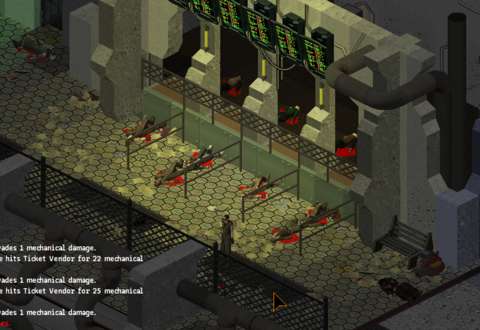
PSIONICS - OVERVIEW:
Psionics are perhaps the most interesting means of combat in Underrail. It is also the most overpowered.
The most significant difference between psionics and other forms of combat is the omission of chance-to-hit RNG rolls. In the earlier builds of the game, there were these. However, they were removed after the developers realize that together with the unique drawbacks of psionics, this made psionics terrible to use.
With vagaries of luck omitted, psionics are easily the most potent combat options, if only because they have guaranteed reliability in most situations.
One of the main unique drawbacks of psionics is also one of its main strength. All psionic powers draw from the same reserves: the player character’s psionic energy. Unlike hitpoints, psionic energy reserves do not improve with each level-up; only feats and the player character’s Will matters (as do some psionic headbands). This means that the player character risks running out of energy if the player is not keeping an eye on its consumption.
On the other hand, the player only needs to worry about the energy reserves. There is no special ammunition to have at the ready, and psionic powers do not have any durability system. Psionic headbands are not subjected to wear and tear either. This is what makes psionic powers the easiest combat options, because the player only needs to consider short-term tactical plans.
However, psionics-oriented characters have a rough start, the reasons for which will be described shortly.
PERMANENT HEALTH REDUCTION:
The player character does not start with psionic abilities. Instead, he/she is informed early on about his/her psionic potential. However, to unlock the potential, the player character has to imbibe something that permanently reduces his/her maximum hit-points by a considerable amount. This can make psionic characters rather fragile, especially when they are in the single-digit levels and have yet to learn other powers.
LEARNING PSIONIC POWERS:
Speaking of which, the basic psionic powers have to be learned through lessons given by instructors in South Gate Station, and even so, this is done at some cost.
The later powers have to be obtained by finding or buying devices that are called Psionic Mentors. Learning the powers is as simple as right-clicking on the icons for the devices in the inventory. However, Psionic Mentors are not grouped under any category of items; they only appear under the “all items” and “non-quest-related” tabs. This can be a small problem when the player needs to sell off surplus Mentor devices.
When the player character has learned many psionic powers – and after the player has learned how to manage psionic energy reserves – the player character is practically a Swiss army knife. If the player knows how to use the powers in an effective sequence, e.g. damaging enemies before applying the incapacitation de-buff, there are very few things that can stop the player character.
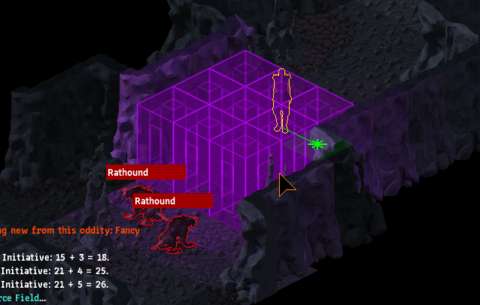
PSIONIC DRUGS:
As mentioned earlier, the player character’s psionic energy reserves are limited. The reserves do replenish over time, but the replenishment rate is generally not enough to maintain pressure on enemies. Therefore, the player character has to use psionic boosters, which restore the reserves.
Psionic boosters are a little costlier than Advanced Health Hypos. They can be crafted with processed Mindshrooms, which grow in many places in the Underrail. However, the total value of the ingredients is considerably higher than the value of the Psi-Booster. This means that it can take some effort to maintain a stock of Psi-Boosters (which practically become the psionic character’s equivalent of ammunition).
Psionic Boosters also have cooldown times, so even with a hoard of this on the player character’s person, the player still has to manage energy reserves carefully.
There are a few other types of substances that benefit psionics, but their schematics and ingredients are only available much later. Some of the rarer ingredients have to obtained through the boring fishing mini-game too (more on this later).
These limitations are the main balancing measures for psionic powers. If the player wants to execute a devastating sequence of psionic powers, the player has to consider his/her character’s starting reserves, replenishment rate, and the effects of substances on these. Fortunately, this is information that is readily available to the player.
NEURAL OVERLOAD:
Neural Overload would be the mainstay of most psionics-oriented characters, though its very short range can be a discouraging drawback.
Its primary advantage is that the damage that it inflicts completely bypasses all resistances and thresholds. It inflicts electrical damage, but it bypasses electrical protection too. Of course, it only works on enemies that actually have minds. When coupled with stealth, Neural Overload can be an easy way to eliminate very hard targets.
ELECTROKINESIS:
Once it has been learnt, Electrokinesis will quickly become the mainstay option of psionic characters. This is because of their damage potential and secondary effects.
This psionic power manifests as a lightning bolt that strikes the target, and then arc over to other nearby characters (including non-hostile ones). The target is also stunned, thus giving this power further tactical value.
Like in other games with arc lightning attacks, the number of arcs that Electrokinesis can make is limited to a hard number. However, other games would apply more limitations, such as insisting that a victim cannot be struck more than once or severely reducing the damage of each subsequent arc. This is not the case in Underrail; the damage drop is a relatively small percentage for each subsequent strike, and a victim can be struck multiple times.
This makes Electrokinesis devastating against two close enemies, perhaps overwhelmingly so. However, the player character is almost always alone, so this advantage is justifiable.
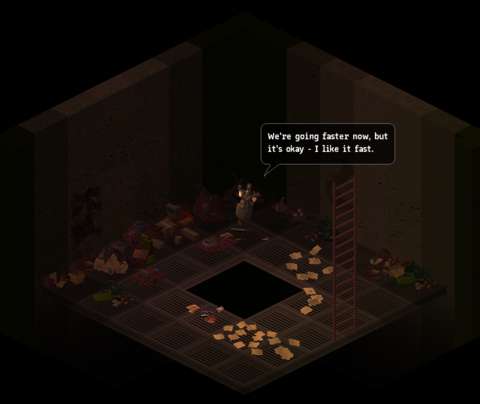
CRYOKINESIS:
Cryokinesis is practically the psionic character’s equivalent of a sniper rifle. It has a range equal to the player character’s sight range, and thanks to having no chance-to-hit RNG rolls, always hits. That the target is inflicted with the “Frozen” de-buff that slows them down makes this psionic power even more effective.
LATER POWERS:
The powers that can be learned later have more situational uses and are a bit more difficult to set up. Yet, if the player can time them just right, they can inflict a lot of damage on very hard targets. For example, there is a psionic power that creates a psionic familiar that mimics the use of kinetic powers, which effectively doubles the damage output of these powers.
FOCUSED STATE:
It has been mentioned earlier that some combat options are more effective when the player character has been standing still. This seemingly minor gameplay element is the “focused” state.
Moving about while not in stealth mode removes the “focused” state. The only way to regain “focus” is to stand still for a second or two while out of combat, and while in combat, by the start of the next turn. The “focused” state is essential for effective use of rifles and crossbows. In actuality, it provides gameplay balancing to these otherwise powerful weapons.
TRIGGERING COMBAT:
Combat can be triggered by the player or NPCs. If the player triggers combat, the player character always goes first. However, the ability to trigger combat does have a cooldown timer. After combat ends (or the player cancels combat, if the situation permits it), the player has to wait several seconds before combat can be manually initiated again. Apparently, this limitation is implemented to prevent abuse of this feature.
INITIATIVE ROLLS:
The other way for combat to begin is for enemies to initiate it. This is actually not desirable, because there are RNG rolls that can turn out poorly for the player.
Every character that is involved in the fight or happens to be nearby will “roll for initiative”. To elaborate, an RNG roll is made for every character and the character’s bonus initiative rating is added to that roll. The character that rolled the highest gets to move first, followed by other characters that rolled consecutively lower. Obviously, luck is a major factor in the outcome.
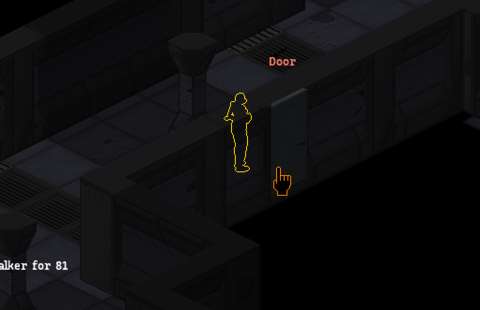
It is generally in the player’s interest to have the player character initiate the fight and thus move first. This is very easy for stealth-oriented characters, who can start combat while in Stealth mode without much of a problem if they have not been detected.
For other characters though, initiating combat can be tricky, especially if the player has yet to learn about actions that can trigger hostilities; there will be more on this later.
COMBAT ENDING IF ALL ENEMIES ARE INCAPACITATED:
Combat, of course, ends when all enemies are dead, or the player character is dead. However, there is another way to disengage from combat.
If all enemies that are aware of the player character’s presence have been inflicted with the Incapacitation de-buff, the combat ends automatically upon the end of the next turn, or when the player chooses to end combat manually (in which case the option to do so would be enabled).
The reason that the player would want to do this is to have the player character flee. In the case of stealth-oriented player characters, this is a good time for them to go back to stealth mode; incapacitated characters cannot detect the presence of any other characters, even if they go into Stealth mode right in front of them.
MEDICINES & DRUGS:
The sci-fi setting of the game means that there are substances that characters can use in order to give them an edge. Since the player character is almost always alone, having such advantages can make a lot of difference.
Firstly, there is the ubiquitous healing hypo; not unlike Stim-paks in Fallout and some other games, these are miraculously instantaneous healing options. However, there are cooldowns on the use of health hypos, so they cannot be abused too readily. Moreover, the cooldowns extend to all types of health hypos, so the player character will need to replace health hypos of lower grades with better ones in order to maintain competitive healing options.
There are a couple of combat performance-enhancing drugs, but these come with severe drawbacks that kick in as soon as their beneficial effects wear off. Incidentally, these drugs are some of the easiest to manufacture because they use few ingredients.
Some other substances have a lot less drawbacks. These are the pill-contained ones. However, their effects are less significant, and their recipes have more ingredients.
Most ingredients for the recipes of drugs have to be derived from organic sources, such as plants, fungi and animal organs. The raw forms of these are heavy things, especially organs, so stocking them can be troublesome. However, the processed products from these tend to be lighter.
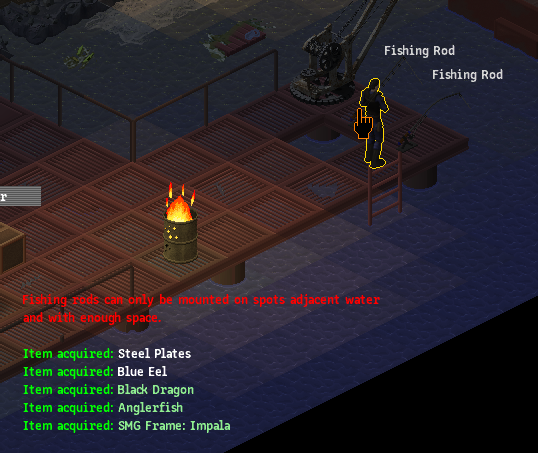
FISHING & ITS MANY PROBLEMS:
Some ingredients for medicines have to be obtained through fishing. This would have been an interesting diversion, if not for it being an onerous mini-game.
Fishing is performed by planting a fishing rod next to a body of water, and then waiting. Of course, this is to be expected of typical shore fishing. There are many problems with it, however.
The first problem is that it is not always clear which location is suitable for planting. A “square” on the shore may seem empty and usable, only to turn out not so when the game informs the player that the square is not a suitable location.
Of course, there are certain rules of the thumb, such as a water “square” cannot have more than one fishing line going into it. Yet, these rules are not always easy to follow. Returning to the example of the rule of one line for each water square, the direction that a fishing line is cast when a rod is planted is not entirely predictable.
Of course, the player character’s facing relative to the body of water when planting a fishing rod determines the direction of the line of the rod, but there is another limitation: fishing lines can only be directed towards one of four directions.
The next problem is the waiting. The time before something pulls at the line varies tremendously; the line could be dipping the moment the rod was planted, or it might only move more than a minute later. There does not seem to be anything that the player can do to influence the waiting time; the most that the player can do is plant more rods, and even so, that would mean rushing from one rod to another.
The third problem happens when the fishing line dips. This is generally quite obvious. However, there are many locations where the colour schemes of the terrain (and sometimes the water) cause the fishing line and rod to blend into them, thus making them hard to see even when they are moving. The fourth problem is that the time of dipping is random; a line may dip just once, but another line may dip repeatedly for a quarter minute.
When the line dips, the player has to click on the rod. This is where the fifth problem occurs: the click-box for the rod is quite small. Moreover, as the line dips and pulls at the rod, the click-box moves together with the rod.
Clicking on a rod triggers the sixth problem: there is an RNG roll that has to be passed in order to retrieve the catch. Of course, the player character’s Dexterity rating is a determinant factor in success, but increasing Dexterity to make fishing easier is a silly thing to do.
(There is a special feat that can be earned through a long-term quest; the feat makes all attempts at retrieving a catch successful. However, by the time the player has managed to finish this quest, he/she would have little more reason to continue playing the game.)
The final problem is that every fishing spot offers finite amounts of successful catches; usually, the player can only have three successful catches in a spot before the lines of the rods no longer dip. The number of successful catches remaining is not clear to the player either. Furthermore, the extent of any fishing spot is not clear; a map might have several fishing spots side by side, but their borders are not shown.
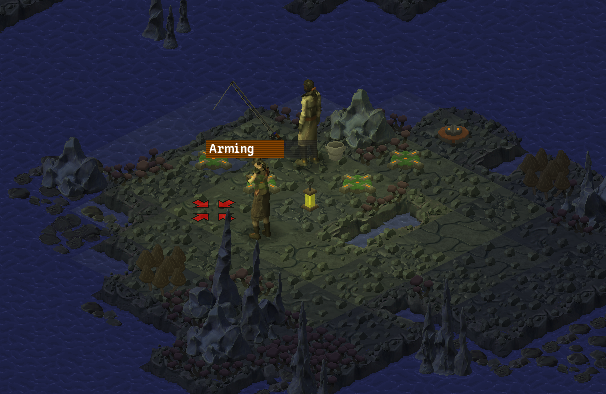
TRIGGERING HOSTILITIES:
If the player character is in permissible areas, non-hostile NPCs would not give much of any thought to things like the player character opening doors or walking around while armed. However, there are certain actions – excepting attacking them – that are guaranteed to raise their ire.
Being seen planting a trap in the vicinity of a character would immediately outrage everyone else in sight. In the case of controlled zones, having the traps detected immediately raise hostilities.
Using a combat option that requires set-up time, such as Aimed Shot, at a target while being seen by the target (or its allies) will also trigger hostilities. This means that non-stealthy characters cannot initiate combat with these options without being subjected to initiative rolls.
Obviously, being caught in places that the player character is not supposed to be in will trigger hostilities. There is no leeway in this matter; trespass (and intrusion) is punished with death.
ENEMIES – IN GENERAL:
There are many things in Underrail that can and/or want to kill the player character. As mentioned earlier, the player character is alone most of the time, so learning about the limitations and strengths of enemies is crucial for survival.
Most enemies go down permanently when they are slain. This is indicated by their sprites being replaced by messy remains, in the case of non-human enemies. When human enemies go down, the labels for their sprites clearly include the word “corpse”. In both cases, their remains/corpses become loot containers.
HUMAN ENEMIES:
When they are engaged in combat, human (or partially human) enemies are among the most intelligent and most dangerous opponents that the player would face.
Many of them are smart enough to use cover, or at least end their turn out of the player character’s line of fire. All human enemies also happen to have the same abilities that the player character can have. For example, Aimed Shot is a particularly common feat among enemies. Human enemies that happen to have different ammo types in their possession will also switch ammunition in order to better hurt the player character.
On the other hand, human enemies do exhibit some unwise or just stupid behaviour.
Most human enemies also have healing items and boosting drugs on their persons, and they will use these to get an edge as early as possible. However, they are not capable of factoring in the drawbacks of the drugs that they are using. For example, the player would be seeing enemies die from the withdrawal effect of morphine (which inflicts damage at half the amount of HP that the user is missing).
The player might also see human enemies doing some goofs, such as failing to account for the action points that are needed to fire a weapon upon having made a move.
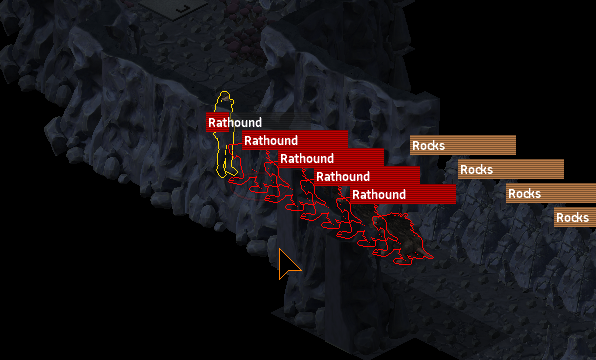
WILD BEASTS:
There are a lot of hideous things in the underworld that are considered “wild animals” by its human denizens. Wild beasts are among the threats that the player character would encounter the earliest, and they will teach a harsh lesson to the unsuspecting player that they are much more challenging to fight than the sundry critters that the player would fight in other RPGs. An example is the Rathounds, whose pack abilities have been described earlier.
The wild beasts of the Underrail can be categorized into “families”, which would be a fitting term because most wild beasts are encountered in groups. A group of them is not always composed of the same type of creature too. For example, Rathound packs that are encountered later have Alpha Rathounds, which are bigger and more menacing variants of Rathounds; packs that are encountered much later have the hulking Ancient Rathounds.
The nastier variants are not only tougher, but they also have abilities that the lesser variants do not have. For example, the Alpha Rathound has the Rend attack, which is guaranteed to inflict bleeding on its target if it hits. Ancient Rathounds do not fear fire, and cannot be stunned or incapacitated at all.
Fortunately, there are NPCs that would describe these wild beasts to the player, specifically about their capabilities. Usually, these are vendors who trade in pelts and crossbow-related gear.
MUTANTS:
Perhaps as an homage to Fallout, Underrail has misshapen former humans too. Underrail’s versions are practically the acid-archetype of enemies: they are resistant to acid, and they have acid-spewing attacks. Furthermore, hurting them causes them to splash acid all over the place, which makes them particularly troublesome for melee-oriented player characters.
RESPAWNING:
Most human enemies stay dead, with the exception of the Ironhead bandits, who always repopulate their camps in Lower Underrail. Wild beasts, however, almost always respawn; they do so after a few hours. This means that the player can kill them repeatedly for ingredients, crafting parts and/or regular XP, but also means that re-treading previously explored areas bears some danger.
LATE-GAME ENEMIES:
Enemies that appear much later in a playthrough would test how prepared the player is for drastic changes in how threats are encountered. The following statements would leave out plot-related details, but the gameplay ones will be mentioned.
Firstly, these enemies primarily inflict Bio-type damage, which previously is mainly associated with poison. Of course, poison can be cured with antidotes, thus preventing any further damage. However, the harm that these late-game enemies inflict cannot be cured in anyway; they are applied immediately, along with nasty secondary effects. Players who have not brought along an armor suit that has been crafted with a Biohazard Vest would be at a severe disadvantage.
Secondly, some of these enemies spawn into a map in different ways. Some of them appear to be objects in the environment, before becoming alive when the player character comes near. Some others only appear after a certain unique de-buff has reached critical levels.
These differences can be unpleasant for players who have become comfortable with the challenges posed by the earlier enemies.
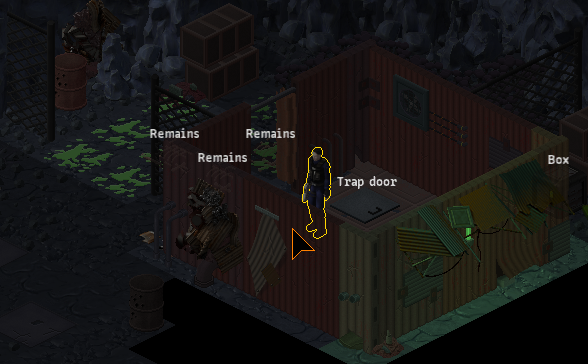
DIFFICULTY SETTINGS:
The difficulty setting that the player sets at the start of a playthrough determines how difficult enemies are in combat, and how weak the player character is.
At the higher settings, the player character has significantly reduced hitpoints. Health hypos also have much longer cooldowns. The combat statistics for enemies remain the same, with one exception: they have initiative rolls that are loaded in favour of them, whereas the player character gets rolls that are loaded against him/her. This means that in cases where NPCs initiate combat instead of the player, they get to move first; this is obviously detrimental to the player.
For better or worse, the highest difficulty setting makes the use of stealth-oriented characters much more feasible over those that are not stealthy, mainly because they can better control the initiation of combat.
DIALOGUE SYSTEM:
As mentioned earlier, there are two dialogue systems: one that happens in real-time, and one that pauses time. The former is used for interaction with elevators and computer terminals; the problem with these has already been mentioned earlier. The other is used for other instances of dialogue, monologue and narration.
The user interface for the dialogue system would be quite familiar to anyone who had experienced the now-defunct Black Isle games. There is a textbox that contains the statements of any character that is talking to the player character, and below that textbox, is a numbered list of replies or decisions that the player can make. Tapping a number button selects the corresponding option.
Narration is worked into the aforementioned textbox via the use of green-coloured font. This contrast can seem a little jarring at first, but it does help a player discern which is flavour text and which is a statement by a character.
Green text, with bracket parentheses, is used to denote the gameplay consequences of would-be decisions. This might seem to be a spoiler, but it does help the player decide which tangible reward (or penalty) to take.
STAT-CHECK:
There are some options/choices that make checks on the player character’s statistics. Most of the time, this is his/her Intelligence rating; a high enough Intelligence would have the player character making deductions about a situation earlier (though the rewards from these are not always significant).
Some other options only appear when the player character has a suitable level of skill in something. For example, an option to repair a broken terminal appears if the player character has a high enough Electronics skill. However, this does not necessarily mean that the player character would be successful at that option, because this skill check is used to determine whether the option appears or not.
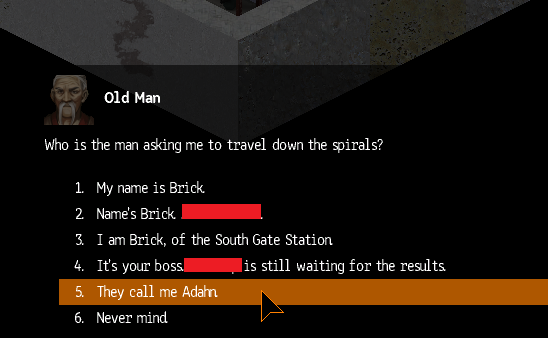
PERSUADE AND INTIMIDATE:
Speaking of checks on skills in the dialogue system, the two skills that contribute the most to the player’s choices in interactions with NPCs are Persuade and Intimidate.
As a veteran of Western RPGs would expect, Persuade options are there as non-violent ways to resolve conflicts. They are generally desirable if the playthrough is using the Oddity XP system, but this also means that the player loses out on the XP bonus that can be obtained from succeeding at Persuade options.
Intimidate checks occur far less frequently than Persuade does, which diminishes its value compared to the latter in matters of role-playing. Of course, Intimidate is used for a feat that can apply de-buffs on many enemies at once, but this ability has a cooldown time that is considerably longer than the duration of the de-buff.
VENDORS - FOREWORD:
The player character will be collecting plenty of stuff that he/she does not need and is practically vendor trash. As to be expected of a Western RPG, there are NPCs that stand around waiting for the player character to come up to them and conduct trade. However, this is not as simple as dumping unwanted things on them and getting money in return.
LIMITED CASH ON VENDORS:
Firstly, vendors have limited amounts of cash; this is not unlike the vendors in the first Fallout game. This means that there are only so many things that the player can sell to a vendor before he/she/it runs out of financially liquid assets. Of course, the player can trade for other things, but vendors do not always sell what the player wants. The vendors do regain their cash reserves upon the refreshing of their stock, but that only happens about one and half hours after the player has purveyed their offerings.
STOCK REFRESH & GAME RELOAD EXPLOIT:
Speaking of which, the timers for stock refreshes only start after the player has opened the barter interface with vendor NPCs. Once the timer ticks down to zero, a vendor’s stock refreshes and items in his/her stock are determined there and then. The data is used to generate the vendor’s stock when the player character trades with them after the refresh has happened.
This data is kept in the game-save file that the player makes after that. However, there appears to be a glitch that causes the game to interpret the data in a slightly different way, as long as the player has made the game-save file before the vendor’s stock has been generated. This glitch can be triggered by restarting the game and reloading the game-save afterwards, and then initiate trading with the vendor in order to generate the stock.
The stock that is generated is subtly different from the stock that would be had if the player had reloaded the save file during a gameplay session. A meticulous player can take advantage of this in order to purview two different sets of stock.
However, any game-save file that is made after a vendor’s stock has been generated will retain that stock upon being reloaded.
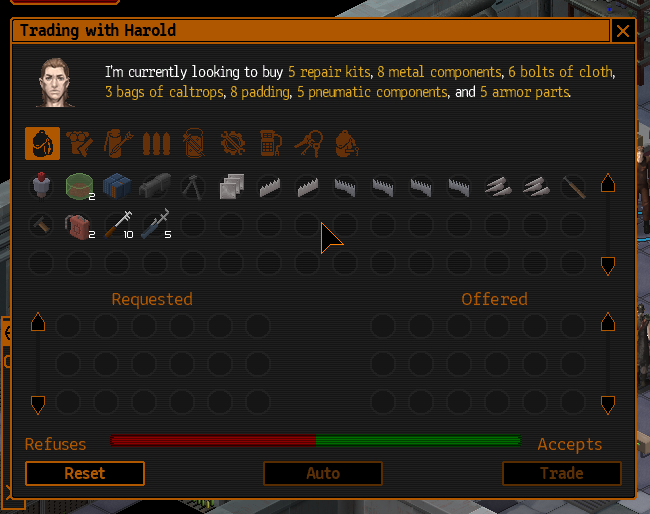
LIMITED SELLING VARIETIES AND QUANTITIES FOR THE PLAYER:
Thus far, the designs on vendors that have been mentioned are interesting and quite understandable. Unfortunately, there are some designs that are not as convincing, and for better or worse, are the developers’ attempt at making their RPG vendors different from others.
The first of these differences is the less acrimonious one. Vendors often specialize in certain types of goods, and so these vendors will only sell and buy these types of goods, which is understandable. Such a limitation has been in place in games like the Elder Scrolls titles and contributes to world-building.
The second difference is much more problematic. Vendors will only ever buy limited amounts of items from the player character. For example, a weapons vendor might only want to buy several pieces of firearms, and will buy no more after that quota is reached.
Considering that there are already the limitations of limited cash on vendors and that vendors only buy specific types of goods, one would think that this is too much.
Of course, there is the argument that these vendors are concerned with inventory control and would not buy things willy-nilly. Yet, such an argument presumes that there is a system in place that determines what and how much they want to buy. There is not any that is convincingly sophisticated.
When the player initiates the trading interface for a vendor after his/her stock has refreshed, the variety and number of items that he/she wants to buy are randomly generated. This can be observed again if the player reloads a game-save that has been made before trading with the vendor but after his/her stock has been refreshed.
In fact, if the player does not want to waste time trekking over to another vendor, he/she would have to resort to this save-scumming so that the vendor would want to buy what the player has.
There could have been a more sophisticated system in place. As a suggestion, the variety and quantity of items that the vendor would want are dependent on his/her current stock. For example, if his/her stock has a lot of items of one type, he/she would not want to buy any more of these. The value of the items that the player wants to sell could have been made as a factor too.
The developers are aware of these complaints, but apparently their response is to implement a silly character with an obsession for picking up useless things.
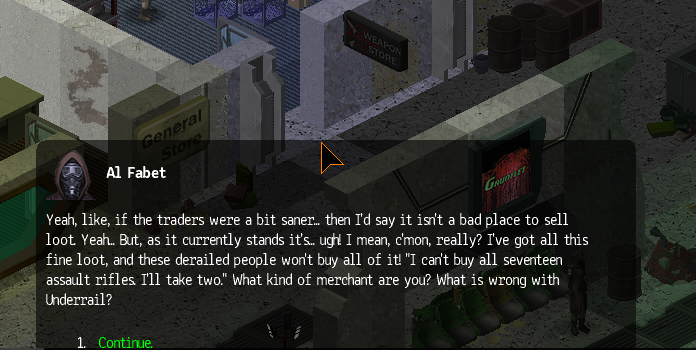
SUPER-STEEL PLATES:
There are not a lot of things to spend currencies on. Besides, the player can trade for what he/she wants by exchanging vendor trash for them.
The developers do realize this, and have implemented a reward for completing a significantly challenging quest. The reward is a special service by an NPC who would take the player character’s hoard of Charon coins (one of the three currencies in South Underrail, and the most commonly accepted one) and smelt them down into super-steel plates, which cannot be obtained anywhere else.
The plates can be used to craft gear that is much lighter than gear made from the other metal alloy materials. There are also secondary benefits, such as slightly lower penalties for movement and stealth in the case of armor suits and lower AP costs in the case of melee weapons. These are very desirable benefits, for there are only very few, if any, other ways to obtain them.
However, the quality of the steel plates is all over the place. The player might have to expend a lot of Charons just to get the quality ratings that he/she wants. Furthermore, the value of the plates is much lower than the value of the Charons that have been consumed. This can be a problem for player characters who specialize in the use of plate armor and melee weapons.
SPECIAL MERCHANDISE:
The Mercantile skill reduces the purchase costs of items, but there are only so many things that the player would want to buy from vendors. The main reason to boost the Mercantile skill though, is the opportunity to get certain vendors to expand their range of offerings.
The additional offerings are marked with orange dashed boxes in the trading interface. They are not guaranteed to be items that the player wants to buy, however. Yet, the expanded range of offerings does increase the chances of there being items that the player would want to have, such as crafting components of particularly high quality.
NO MAP SYSTEM:
One of the most glaring problems in this game is the lack of a system that tracks the maps that the player has explored, and how they are connected to each other. In fact, the player would have to resort to fan-made maps to get his/her bearings, at least until familiarity renders that unnecessary.
(Note: Apparently, the developer mentioned that the omission was simply due to design oversight; in its eagerness to complete the design of features that it finds more exciting, the implementation of a map system was just overlooked.)
VISUAL DESIGNS:
Underrail is not a pretty game. If one looks at the earlier build of the game, the developers have been using placeholder objects for many things, or assets that are so plain or ugly that they fit the “developer art” stereotype.
In the current build, objects and characters are much more recognizable, but their assets are reused for so many things. The most noticeable example of this complaint is the use of the same character portrait for dozens of characters, named and unnamed. Human character models are even more over-used.
Still, there is some attempt by the game’s artists to inject some interesting details to the graphics of the game. For example, there is the background and lighting of player character’s portrait, which changes as the player character moves from one part of a map to another.
There are also locales where unique artwork has been used for the background and foreground; fittingly, these appear in particularly momentous occasions in the story.
There is the grid-like look to almost every map and level. Shorelines are composed of isometric squares and holes in the ground are square-shaped. It would not take long for an observant player to realize that the maps have been made by attaching strings and clusters of square cells together before the cells are populated with objects and sprites.
Non-humanoid characters have their own unique sets of animations for moving around, attacking and dying. This speaks well for the artists’ dedication at expressing the lore of Underrail’s subterranean realm.
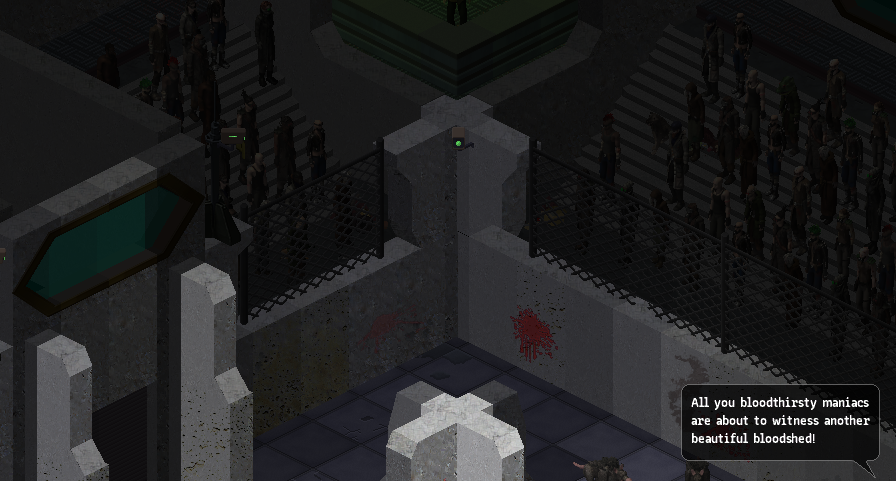
However, human characters look plain by comparison. There is some attempt at including variations between sprites, such as sprites for females and males, but the animations for one human character is practically used for the others too, with no consideration for circumstances. For example, the death animation for all human characters is that they fall over onto their backs and blood decals pool out underneath their sprites, regardless of the cause of death.
(The player should not be expecting anything like the gory death animations in the first two Fallout games.)
SOUND DESIGNS:
There are next to no voice-overs whatsoever. The closest thing that would resemble a human voice is the sound clip that accompanies the Yell ability and psionic powers that inflict terror on victims.
Perhaps this is for the better, because the developers are not native English speakers and there are so many characters to be voiced. Yet, this also means that the developers have little means other than plenty of writing to make specific characters stand out.
In contrast, non-human characters have utterances and other sound clips to indicate that they are not human. For example, dogs bark occasionally and yelp when they are killed. More ghastly sounds are, fittingly, used for the more hideous of non-human creatures.
All combat animations are accompanied by sound clips. For example, throwing knives emit low but audible whooshes when they are thrown.
The music is perhaps the most notable of the sound designs. Most of them fit the setting and themes in the game. For example, the tracks that are used for dark and dangerous areas, such as “Subterranon”, sound ominous. There are also sound tracks that are associated with the presence of characters of certain factions. For example, wherever there is a prominent presence of the cyborg Faceless in a map, the game always plays their signature track, “Unnatural Order”.
WRITING:
As mentioned already, Underrail attempts to make up for its aesthetic shortfall with writing – and it would be quite good, even in the eyes of very jaded and demanding beholders. This is all the more surprising, because the writers, including the main writer (and lead developer) Dejan Radisic, are Serbian. Although there are a scant few cases of typos and malapropism, the writing is very passable and more importantly, amusingly expressive. Some of the text in the screenshots that have been included in this article would be good examples of this.
SUMMARY:
Underrail is not a spiritual successor to the first two Fallout games, as some would claim. Rather, it is something else, and is deserving of a special place of its own in the Western RPG sub-genre.
For one, Underrail is chockful of checks and balances for gameplay, even when they might seem odd, such as in the case of cooldowns for the use of grenades. Yet, it also offers plenty of options to develop and trick out a player character, such that even the disadvantage of always being outnumbered would seem surmountable. These make the game quite challenging to play, yet rewarding for meticulous players who favour tactical acumen and guile as the deciding factors in combat.
Perhaps its most outstanding aspect is its sci-fi Hollow Earth setting. Not many games have fiction that take place in the underground, due to the limitations that such a setting would impose. There is considerable wonderment, albeit tinged with bewilderment, of how humanity and other things can survive underground.
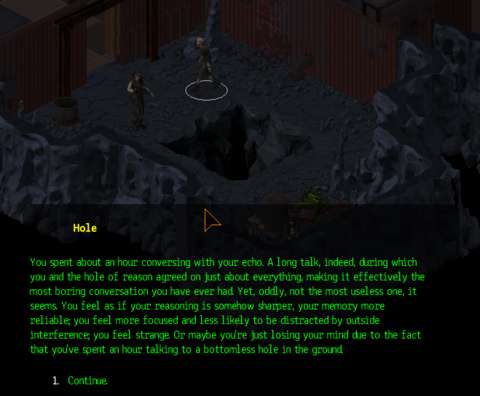
Unfortunately, Underrail has its share of problems. There is the unwise and outdated limitation of a maximum 95% probability of hitting something with a ranged or melee weapon. There is the luck-rolled mixture of items that vendors are willing to buy in limited luck-rolled quantities (and the developers’ subtly sarcastic response to complaints about this). There are some flaws in the crafting feature that complicate the consumption of crafting resources. There are promises to fix some issues, such as the lack of a map system.
There is also the matter of the game’s aesthetic designs. Although some people (myself included) have low demands when it comes to matters of graphics and sounds, there would be people who would be put off by the game’s simple visuals and sound designs, especially if they have been spoiled by other games with sprites and artwork that are far more impressive.
Yet, despite its flaws, Underrail is still a gem of a game, especially for those who yearn for the days when Western RPGs had considerable complexity in their gameplay and had fresh story-telling.
